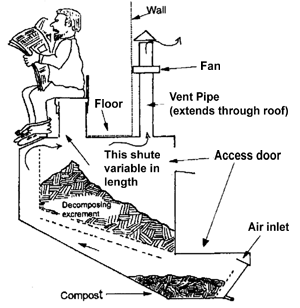
PO Box 1611, Chico, ca. 95927
Web Site: http://buttecreekwatershed.org
The Butte Creek
Watershed Owner's Manual
What is a Best Management Practice?
Why should I care?
Best Management Practice is a term
used by many government agencies and resource professionals to describe the
best way of restoring, maintaining, or using the soil, water, plants and
animals on your property.
Our soil and the water that flows
over and through it are our most basic assets. The conditions of other natural
resources in a watershed, such as vegetation and animal life, are in many ways
indicative of the underlying health of watershed soil and water. The
inter-dependence of the many factors that make up natural resource systems
requires comprehensive planning and management. This achieves maximum long-term
benefits from natural resources, without diminishing their availability.
Planning and managing such a complex system cannot be done by single,
individual effort. It is best accomplished through the cumulative effects of
cooperative community awareness and involvement.
This Owner's
Manual was produced
with a generous grant to the Butte Creek Watershed Conservancy from the Great Valley Center through its LEGACI grant program. Each year, the
Center awards well over one-half million dollars in monetary grants to
non-profit groups, community organizations, and local governments that are
working to improve the well being of the Great Central Valley through
initiatives in the areas of Land Use, Economic development, Growth,
Agriculture, Conservation and Investment, (LEGACI).
The limitations of budget
and time required the scope of this Best Management Practices Manual to be
limited to land and homeowners with 40 acres or less. The subjects covered in
this Manual will be those encountered by our stakeholders controlling parcels
of 40 acres or less. This Manual is not intended to cover commercial
development or farming. Those subjects will be covered in a Best Management
Practice Manual for future publication.
The Owner's
Manual is designed to accomplish the goal of maintaining a sustainable
balance between the natural and human resources within the watershed. With increasing population and diversity of
land use in the watershed, a holistic approach to managing resources helps to
decrease negative impacts and to increase positive impacts. Economic vitality
is necessary to enable the community to address and solve resource problems
such as non-point source pollution, and maintaining a healthy natural resource
base is necessary for sustaining economic vitality.
Voluntary implementation of best management
practices not only helps deal with identified problems but prevents others from
occurring. The Owner's Manual is intended to serve as a preventive
maintenance effort, rather than the usual after the fact clean up or
mitigation program. Solutions to problems identified by citizens, landowners,
and agencies are more easily remedied when the problems are treated as vested
interests to be addressed, instead of positions to be defended. This proposal
provides the basis for a voluntary landowner effort to jointly address the
concerns expressed by the local community, while protecting and preserving the
natural and cultural resources in an economically reasonable manner. Preventive
care is the least burdensome and least expensive way to keep the watershed
healthy.

Preface & Acknowledgements
The Butte Creek Watershed
Owner's Manual
A Best Management Practice Manual
The
Butte Creek Watershed Owner's Manual is part of the Butte Creek Watershed
Conservancy's implementation of its Watershed Management Strategy. On November
14, 2000 the BCWC Board of Directors voted to accept the Watershed Management
Strategy. This Watershed Management Strategy is designed to accomplish the goal
of maintaining a sustainable river ecosystem for the Butte Creek watershed.
With increasing population and diversifying land use in the watershed,
coordinated management becomes beneficial. This decreases negative impacts and
increases positive impacts. Economic
vitality is necessary to enable the community to address and solve resource
problems. This maintains a healthy natural resource base, which is necessary
for sustaining that economic vitality. Establishment of a goal-oriented
management strategy can prevent problems before they occur, and will result in
less expensive and more efficient use of community energy and resources. This
important document can be viewed on the Conservancy's web site at: http://buttecreekwatershed.org.
Objective #2: in Chapter 1, Education and Public Outreach states: Develop a strong education and public outreach program to encourage conservation and wise use of natural resources and preservation of the economic and cultural heritage of the watershed.
Implementation 2.A states: Encourage development of a manual of Best Management Practices applicable to the continued multiple land uses found in the Butte Creek watershed and make this manual available to landowners and resource managers in the watershed.
We
thank the following people and agencies for their valuable assistance in the
production of the Butte Creek Watershed Owners Manual.
|
Kenneth N. Derucher, Ph.D. Dean and Professor California
State University, Chico |
John Icanberry US Fish and Wildlife
Service |
Paul Ward Biologist California
Dept. Fish and Game |
|
Glenn Nader Farm Advisor Livestock & Natural
Resources Sutter/Yuba/Butte
Counties |
Mike Madden Office of Emergency Services |
Great Valley Center Modesto, CA |
|
Laura Best Assistant
Editor |
Sharan Quigley Assistant Editor |
|
|
The Best Management Practices Committee: Rick Ponciano Rick Hall Sharan Quigley Morris Boeger Les Heringer Chuck Kutz Hank Evers Jack Bean Robb Cheal Ed Chombeau Ken Keller |
||
About the
Butte Creek Watershed Conservancy
The Conservancy received non-profit 501(c)3 status in November 1996. The Conservancy was created as a
landowner-driven group, and a 12-member Board of Directors directs its policies.
Current Board members are community leaders in agriculture, timber, cattle
grazing, local industry, and conservation. The Butte Creek Watershed Conservancy
was formed to encourage the preservation and proper management of the Butte
Creek Watershed through watershed-wide cooperation between landowners, water
users, recreational users, conservation groups, and local, state, and federal
agencies. The mission statement of the Conservancy reflects that dedication:
"The Butte Creek Watershed Conservancy was established to protect, restore, and
enhance the cultural, economic, and ecological heritage of the Butte Creek
Watershed through cooperative landowner action."
To join the Conservancy call (530) 893-5399 or Email us at:
creek@inreach.com
Write to:
Butte Creek Watershed Conservancy
P.O. Box 1611
Chico, CA
95927
|
Butte Creek originates on the western slope of the Sierra Nevada at an elevation of approximately 7,000 feet. Run-off originating from snow and rainfall feed six named and two unnamed tributaries that flow into the Jonesville Basin in Lassen National Forest in an area dominated by species of pine, cedar, and fir. Riffle substrate consists primarily of cobbles and gravel. In this reach, the stream flows all year, but peak flows generally occur between October and May. Early peak flows result from rainfall, and late season peak flows result from snowmelt. Stream temperatures remain cool all year and several species of trout are the dominant species of fish (Leach and Van Woert, 1968). Butte Creek cascades from the Butte Meadows area approximately 25 miles through a steep canyon to the point where it enters the valley floor near Chico. Numerous
small tributaries and springs enter the creek in the canyon area. Deep, shaded pools surrounded by species of
pine and fir form the landscape in the section of the canyon above Centerville, whereas the area below has a
shallower gradient and a riparian canopy of alder, oak, sycamore and willow. Several tributaries add flow to Butte Creek
in the canyon. Flows from the West Branch of the Feather River, diverted by Pacific
Gas and Electric Company (PG&E) for power generation, enter Butte Creek
via the Toadtown/Hendricks Canal at the DeSabla Powerhouse. PG&E and its predecessor (Butte County
Electric Power and Lighting Company) have utilized two dams to divert water
from Butte Creek for power generation since the turn of the century. Another diversion, the Forks of the Butte
Hydroelectric Project, was completed in 1991 by the Energy Growth Partnership
I. The lowermost structure, the
Centerville Diversion Dam, located immediately below the DeSabla Powerhouse,
is generally considered to be the upper limit of anadromous fish
migration. Spring-run chinook
salmon and steelhead trout utilize the canyon reach below the Quartz Bowl for
holding and spawning. |
Butte Creek enters the Sacramento Valley southeast of Chico and meanders in a southwesterly direction to the initial point of entry into the Sacramento River at Butte Slough. A second point of entry into the Sacramento River is through the Sutter Bypass and Sacramento Slough. Oaks, cottonwoods, and willows are common along the banks of the upper section of this reach (CDFG, 1974). The creek is bordered by levees in various areas of the valley reach. Four dams and numerous diversions in the valley section divert water from the creek for agricultural and wildlife purposes (McGill, 1987). Fall-run chinook salmon spawn predominantly in this reach between the Highway 99 crossing and the Western Canal crossing in October and November. Adult spring-run chinook salmon pass through this reach from March to June (CDFG, 1993). Juvenile salmon from both races rear here in late winter through late spring en route to the Pacific Ocean. Butte Creek water passes through the Butte Basin, Butte Sink, Butte Slough, and the Sutter Bypass before joining the Sacramento River. Creek water flows through twin channels, the East and West borrow pits, all year and Butte Slough Outfall during flood flows in the fall, winter, and spring. The borrow pits are regular, excavated channels on either side of the Sutter Bypass. The creek gains flow here through the return of irrigation water. Gates on Willow Slough and the East-West borrow pit diversion structure are used to control water levels in the East borrow pit (Slebodnick, 1976). Dams impound and divert water for wildlife and agricultural uses. Willows are the dominant riparian plant species. Butte Creek and Sacramento River salmon and steelhead rear in these waters throughout the year. The watershed's richly diverse and considerable natural resources provide ideal habitat for many aquatic and terrestrial species. The natural resources are also ideal for timber harvest, agriculture, and myriad recreational opportunities. Stewardship practices that consider all uses dependent on the watershed's natural resources will insure their continued preservation. |
|
|
|
|
|
|
|
|

|
|
|
|
Onsite/septic system
owners need information on how septic systems work, how to maintain them, and
precautions to take to decrease the potential for the septic system to
contaminate groundwater or surface water. Operation and maintenance of the
system are the owner's responsibility. Managing a household
septic system requires that you control the volume and quality of wastewater
and maintain the septic tank and drainfield. A properly maintained system
should work correctly for many years. Volume of Wastewater
Sending wastewater to the tank too fast can cause
solid materials to pass into the drainfield without undergoing the gradual
anaerobic digestion that occurs in the septic tank.
Quality of
Wastewater
The quality of your wastewater, not just its
quantity, is also important in ensuring that your septic system functions
properly.
|
Maintaining
the Septic Tank
Slow accumulations of sludge and scum are normal.
You should remove these materials through periodic pumping and appropriate
disposal.
Maintaining
the Drain Field
|
|||
|
|
|||
|
Maintaining Your
Septic System
Out of sight and
out of mind - does this describe your relationship with your septic system?
If you are like most homeowners, you probably never give much thought to what
happens to what goes down your drain. But if you rely on a septic system to
treat and dispose of your household wastewater, what you don't know can hurt
you. Proper operation and maintenance of your septic system can have a significant
impact on how well it works and how long it lasts, and in most communities,
septic system maintenance is the responsibility of the homeowner. Why Maintain Your
System?
There are three
main reasons why septic system maintenance is so important. The first reason
is money. Failing septic systems are expensive to repair or replace, and poor
maintenance is a common cause of early system failures. The minimal amount of
preventative maintenance that septic systems require costs very little in
comparison. For example, it typically costs from $3,000 to $10,000 to replace
a failing septic system with a new one, compared to approximately $50 to $150
to have a septic system inspected, and $150 to $250 to have it pumped. |
The second and
most important reason to maintain your system is to protect the health of
your family, your community, and the environment. When septic systems fail,
inadequately treated household wastewater is released into the environment.
Any contact with untreated human waste can pose significant health risks, and
untreated wastewater from failing septic systems can contaminate nearby
wells, groundwater, and drinking water sources. Chemicals
improperly released through a septic system also can pollute local water
sources and can contribute to system failures. For this reason it is
important for homeowners to educate themselves about what should and should
not be disposed of through a septic system. Finally, the
third reason to maintain your septic system is to protect the economic health
of your community. Failed septic systems can cause property values to
decline. Sometimes building permits cannot be issued or real estate sales can
be delayed for these properties until systems are repaired or replaced. Also,
failed septic systems can contribute to the pollution of local rivers, lakes,
and shorelines that your community uses for commercial or recreational |
|
|
Typical Septic System Layout

Inspecting Your Septic System
Annual inspections
of your septic system are recommended to
ensure that it is working properly and to determine when the septic tank should be pumped. By inspecting and pumping your
system regularly, you can prevent the high cost of septic system failure. If
the sludge depth is equal to one third or more of the liquid depth, the tank
should be pumped.
A thorough
septic system inspection will include the following steps:
1. Locating the system Even a professional may have trouble locating your system if the access to your tank is buried. One way to start looking is to go in your basement and determine the direction the sewer pipe goes out through the wall. Then start probing the soil with a thin metal rod 10 to 15 feet from the foundation. Once your system is found, be sure to keep a map of it on hand to save time on future service visits.
2. Uncovering the manhole and inspection ports
This may entail some digging in your yard. If they are buried, try to
make inspections. Install risers (elevated access covers) if
necessary. 3. Flushing the toilets
This is done to determine
if the plumbing going to the system is working correctly. |
4. Measuring the scum and sludge layers
There are two frequently used methods for measuring the sludge and scum
layers inside your tank. The contractor may use a hollow clear plastic tube
that is pushed through the different layers to the bottom of the tank. When
brought back up, the tube retains a sample showing a cross section of the
inside of the tank. The layers can also be measured using long wooden sticks
or poles. As a general guideline, if the scum layer is within three inches of
the bottom of the inlet baffle, the tank should be pumped. If the sludge
depth is equal to one third or more of the liquid depth, the tank should be
pumped.
5. Checking the tank and the drain field
The contractor will check the condition of the baffles or tees, the walls of
the tank for cracks, and the drain field for any signs of failure. If your
system includes a distribution box, drop box, or pump, the contractor will
check these too. Properly sited, designed, constructed, and maintained septic systems can provide
an efficient and economical wastewater treatment alternative to public sewer
systems. While septic systems are designed and installed by licensed
professionals to meet the needs of individual sites, homeowners are
responsible for the system's operation and maintenance. |

Measuring
Sludge Accumulation
Sludge depth can
be measured by securing a towel around the bottom 3 feet of an 8-foot piece
of lumber. Lower the pole into the tank until it touches bottom and hold it
for several minutes.
BE CAREFUL! Never lean into or enter a septic tank. You could be
poisoned or asphyxiated. Never use matches or flames when inspecting a septic
tank. The gases generated in a septic tank are explosive and deadly.
Slowly raise the
pole and observe the towel. The discolored portion indicates the depth of the
sludge layer. Have the tank cleaned if it is more than 24 inches deep. A
septic plumbing contractor should be hired to pump out and inspect the tank.
If your tank has been recently installed, check the sludge and scum levels
every year to determine how rapidly solids are accumulating in the tank. |
Measuring Scum
Accumulation
The scum layer can be
measured by using a stick to which a weighted flap has been attached with a
hinge. When the flap-end of the stick is forced through the scum layer, the
weighted flap will fall into the horizontal position. Raise the stick until
resistance is felt from contact with the bottom of the scum layer. Place a
mark on the stick where it meets the top of the inspection port. Then
position the flap so that it is under the bottom of the sub-merged outlet.
Again, mark the stick where
it meets the top of the tank. Remove
the stick and note the distance between the two marks. Have the tank
cleaned if the distance is 3 inches or less. If you
choose to do these, remember that the liquid and solid contents of the septic
system are capable of causing infectious diseases. After working on any part of
the septic system, always wash hands thoroughly before eating, drinking, or
smoking. Change clothes before coming into contact with food or other people. |
Procedures for measuring the
accumulation of sludge
and scum
layers in a septic tank.


|
Water
Wells - Water Quality Testing |
|
|
Laboratory testing is the only sure means to detect
contaminants in your water. The following tests; nitrates, coliform bacteria,
pH, and total dissolved solids (TDS), if taken yearly, will give you a
general idea about the quality of your water. If these test results meet
federal and state standards, your water is probably of good quality. Call several different labs to find out their prices
and sampling procedures. The county extension office has a list of
state-certified labs and the contaminants they can analyze for. Some labs
will send you empty bottles with complete sampling instructions. Accurate
test results depend on how well you follow the directions. After the lab has completed the tests, they will send
you a copy of the results. Your local health department can probably help you
interpret the results.
Microorganisms
Microorganisms in your
drinking water can make you sick. Unfortunately, testing for all specific
types of harmful microorganisms is expensive and essentially impossible.
However, coliform bacteria are good indicators of the microbiological quality
of drinking water. |
Coliform
bacteria Coliform bacteria live in the soil, decaying plant
material, and the intestines of humans and animals. Microorganisms in your
water can cause various gastrointestinal illnesses such as dysentery and
cholera. The test for coliform bacteria is an indicator of the
microbiological quality of water. A positive coliform test means that your
water may be contaminated with other harmful microorganisms. A laboratory test for coliform bacteria is simple and
inexpensive. Call several certified labs for their costs and sampling
procedures. Be certain to follow the lab instructions carefully so you do not
accidentally contaminate the sample. If lab results show microorganisms in your water,
check the integrity of the well casing and grout seal around the borehole.
Water and contaminants can seep into the well from the surface if the casing
or grout seal is cracked.
You can decontaminate your well several ways. For
example, you can shock-chlorinate the system by putting large amounts of
household chlorine bleach directly in the well and allowing it to sit
undisturbed for up to 24 hours. To ensure purity, test the water one or two weeks
after shock-chlorinating. If your well is still contaminated, you must take
other measures. You may have to install a water-purifying unit at the well to
treat all the water entering your home. These units include continuous feed
pumps, ultraviolet lamps, and ozonation devices. Emergency
Disinfection |
|
Water
Wells - Pollution Causes |
|
|
California Water
Code Section 231 requires the California Department of Water Resources (DWR) to develop well standards to protect California's ground water quality.
The standards apply
to all water well drillers in California and the local agencies that enforce
them.
By law, DWR is responsible for issuing standards for constructing, altering, maintaining, and destroying wells to prevent pollution. DWR's well standards
provide minimum standards for the
construction, alteration, maintenance, or destruction of wells to prevent
pollution of ground water. |
Items addressed by DWR well standards include: • Setback of wells
from pollution sources • Casing materials • Annular seal
dimensions and materials • Surface features—pads, locks, covers,
backflow preventers, vaults • Well development • Disinfection • Repair • Destruction
Local governments,
counties, cities, and some water districts are responsible for enforcing
standards that are either equal to or more stringent than DWR's well
standards. These agencies usually require permits for well construction. They also conduct
inspections to make sure the wells are constructed properly. To determine who
enforces well standards in your community, contact your local county environmental
health department. |
|
In 1994, the California Building Standards
Commission approved guidelines for installing "graywater" systems
in homes throughout the state. The move was a significant step in making
reuse of some residential wastewater a reality. "Graywater" refers to water already used
in the washing machine, bathtub or shower. Subsurface plumbing systems
allowed under the standards allow homeowners to reuse such water for
irrigating trees, landscaping, and other ground cover. The standards include
a number of provisions aimed at educating homeowners and ensuring safe use of
graywater. Systems generally consist of a three-way diverter
valve, a treatment assembly such as a sand filter, a holding tank, a bilge
pump, and an irrigation or leaching system. The holding tank cools the water
and temporarily holds it back from the drain hose. Systems can either be custom designed and
built, or purchased as a package. Techniques include recessed or raised
planter soilboxes, water injection without erosion, gravity or pressure leach
chamber, and irrigated greenhouses. Some system components can retrofit
existing irrigation systems. Because conventional wastewater plumbing lines combine black and graywater, separating the two generally involves a parallel wastewater system. Space must be available for larger components such as a holding tank or some filters, which can be located in a basement, shed, or possibly outside. |
Benefits/CostsBeside the initial cost of separating black and
greywater plumbing lines, and sand filter costs about $1000, plus one or more
hours of labor. Prices are site-specific and vary widely depending on flow
rate, water quality, temperature, and the local building authorities. In new
construction, the septic wastewater treatment system can often be downsized
as a result of reducing its expected load, and separation of the plumbing
lines will be simpler and less costly than in a retrofit installation. LimitationsContaminants such as paint, bleach, and dye must
be diverted to a separate treatment process such as a septic tank. Periodic maintenance of the graywater
treatment system is required. Code/RegulatoryLocal regulations, sanitary engineers, inspectors,
and boards of health might not be familiar with or permit these methods.
Graywater separation might also not be justification for downsizing the
septic system. AvailabilityThere are several local distributors of tank and
filtration systems; pumps are widely available. Other system components are
essentially conventional construction materials. |
|
Rain Water Harvesting System Components |
||
|
|
||
|
Whether the system you are planning is large or
small, all rainwater harvesting systems comprise six basic components: 1.
Catchment Area/Roof, the surface upon which
the rain falls, 2.
Gutters and Downspouts, the transport channels
from catchment surface to storage; 3.
Leaf Screens and
Roofwashers, the systems that remove contaminants and debris; 4.
Cisterns or Storage Tanks,
where
collected rainwater is stored; 5.
Conveying, the delivery system for
the treated rainwater, either by gravity or pump; and, 6.
Water Treatment, filters and equipment, and
additives to settle, filter, and disinfect. |
||
1. CATCHMENT AREA
The catchment area is the surface on which the
rain that will be collected falls. Channeled gullies along driveways or swales in yards can also serve as
catchment areas, collecting and then directing the rain to a French drain or
bermed detention area. Rainwater
harvested from catchment surfaces along the ground, because of the increased
risk of contamination, should only be used for lawn watering. For in-home use, the roofs of buildings are
the primary catchment areas, which, in rural settings, can include
outbuildings such as barns and sheds. A
"rainbarn" is a term describing an open-sided shed designed with a
large roof area for catchment, with the cisterns placed inside along with
other farm implements. |
|
|
|
Rain Water Harvesting System Components |
|
|
2. GUTTERS AND DOWNSPOUTS These are the components that catch the rain from
the roof catchment surface and transport it to the cistern. Standard shapes and sizes are easily
obtained and maintained, although custom-fabricated profiles are also
available to maximize the total amount of harvested rainfall. Gutters and downspouts must be properly
sized, sloped, and installed in order to maximize the quantity of harvested
rain. |
Gutter
Filter
Downspout
Filter
|
3. ROOFWASHERS
Roof washing, or the collection and disposal of
the first flush of water from a roof, is of particular concern if the
collected rainwater is to be used for human consumption, since the first
flush picks up most of the dirt, debris, and contaminants, such as bird
droppings, that have collected on the roof and in the gutters during dry
periods. |
|
4. STORAGE TANKS
Other than the roof, which is an assumed cost in
most building projects, the storage tank represents the largest investment in
a rainwater harvesting system. To
maximize the efficiency of your system, your building plan should reflect
decisions about optimal placement, capacity, and material selection for the
cistern.
|
Round
Cistern
|
|
Rain Water Harvesting System Components |
|
5. CONVEYING Remember,
water only flows downhill unless you pump it. The old adage that gravity flow
works only if the tank is higher than the kitchen sink accurately portrays
the physics at work. The water pressure for a gravity system depends on the
difference in elevation between the storage tank and the faucet. Water gains
one pound per square inch of pressure for every 2.31 feet of rise or lift. Many
plumbing fixtures and appliances require 20 psi for proper design
consideration. |
|
6. WATER TREATMENT Before making a decision about what type of water
treatment method to use, have your water tested by an approved laboratory and
determine whether your water will be used for potable or non-potable uses. Dirt, rust, scale, silt and other suspended
particles, bird and rodent feces, airborne bacteria and cysts will
inadvertently find their way into the cistern or storage tank even when
design features such as roof washers, screens, and tight-fitting lids are
properly installed. Water can be unsatisfactory without being unsafe;
therefore, filtration and some form of disinfection are the minimum
recommended treatment if the water is to be used for human consumption
(drinking, brushing teeth, or cooking). The types of treatment units most
commonly used by rainwater systems are filters that remove sediment, in
concert with either an ultraviolet light or chemical disinfection. FILTERS
Filtration can be as simple as using cartridge
filters, or those for swimming pools and hot tubs. In all cases, proper
filter operation and maintenance in accordance with the instruction manual
for that specific filter must be followed to ensure safety. Once screens and
roofwashers remove large debris, other filters are available which help
improve rainwater quality. Keep in mind that most filters on the market are
designed to treat municipal water or well water.
Rain Water Filter |
Composting ToiletsComposting toilets can close the nutrient cycle, turning a dangerous waste product into safe compost, without the smell, hassle, or fly problems. They are usually less expensive than conventional septic systems and they will reduce household water consumption by at least 25%.
Basic System A composting toilet has three basic elements: a place to sit, a composting chamber, and a drying tray. Most models combine all three elements in a single enclosure, although some models have separate seating, with the composting chamber installed in the basement or under the house. In either case, the drying tray is positioned under the composting chamber, and some sort of removable finishing drawer is supplied to carry off the finished product. |
Ninety percent of what goes into a composting toilet is water. Compost piles need to be damp to work well, but most composting toilets suffer from too much water. Evaporation is the primary way a composting toilet gets rid of excess water. If evaporation can't keep up, then many units have an overflow that is plumbed to the household greywater or septic system. Warmth and air flow through the unit assist the evaporation process. Every composting toilet has a vertical vent pipe to carry off moisture. Air flows across the drying trays, around and through the pile, then up the vent to the outside of the building. The low-grade heat produced by composting is supposed to provide sufficient updraft to carry vapor up the vent. However, like any passive vent with minimal heat, these are subject to downdrafts. Electric composters use vent fans and a small heating element as standard equipment. There are optional vent fans for non-electric models that can be battery or solar-driven. Smaller composters certainly cost less, but because the pile is smaller they are more susceptible than larger models to all the problems that can plague any compost pile, such as liquid accumulation, insect infestations, low temperatures, and an unbalanced carbon/nitrogen ratio. Smaller composters require the user to take a more active role in the day-to-day maintenance of the unit. Smaller units with electric fans and thermostatically controlled heaters have far fewer problems than the totally non-electric units. So be aware that the less-expensive composting toilets have hidden, and long-range costs.
Smaller
System |
|
Soil Erosion
Soil, Erosion, and Sediment |
|
|
Soil is more than just the brown muddy stuff you track in after a rainstorm. It is an intricate composite of living microorganisms, organic matter, and mineral matter worn down from parent rocks. The process from rock to soil is a slow one. An average inch of topsoil, the richest of the soil layers in organic matter, takes hundreds of years to form. As any home gardener knows, soils vary widely in fertility, mineral content, physical structure and the way they react to wind or water. Some soils drain slowly, making them a poor surface for roads or septic systems. Others are highly erodible and at the least disturbance can lead to a gully or streambank washout. Soil erosion is a natural process. In stable watersheds the rate of erosion is slow, and natural healing processes can keep up with it. But in many watersheds, the high level of human disturbance has accelerated the rate of erosion beyond nature's healing qualities, and if not controlled, could have a long-term detrimental affect on Butte Creek. The effects of soil erosion are not limited to the site where the soil is lost. The detached soil, called sediment, enters the water system and settles out, at a culvert inlet, a stream channel, or in a lake. Some sediment is needed to bring nutrients and substrate materials to aquatic ecosystems, but too much sediment causes problems. In the water, sediments limit sunlight penetration, which robs aquatic plants of the light they require to live. In turn, fish and other aquatic animals are deprived of the oxygen provided by plants. Sand and silt particles moving through the water can literally scrub plants and animals off streambed surfaces. When waterborne soil particles eventually settle to the bottom of streams, they can smother fish eggs and other aquatic life. Sediments can also reduce stream channel capacity, causing further localized erosion and flooding. |
Plants are a natural, inexpensive, and highly effective means of controlling runoff and erosion. Runoff slows down when it reaches a strip of vegetation and lose much of its erosive force. Vegetation also works as a filter, straining out sediment and debris, and absorbing other pollutants. Some of the major problems caused by erosion are: Degradation of water qualityAs eroded material enters
streams and channels, it degrades water quality both in the streams and in
receiving waters such as Butte Creek. The eroded material contains nutrient
loading Flooding Development/Construction
|
|
Erosion Control Basics of Erosion Control |
|
Basic Rules for
Preventing Erosion
Protect bare soil surfaces. Vegetation is the best protection because it both absorbs and uses water. Minimize
hard surfaces to maximize the water absorption capacity of your
land. Avoid compacting soils by minimizing traffic and tillage operations
when soils are wet. Keep heavy equipment off exposed soil during the rainy
season. Use gravel for parking areas. Do not concentrate water flow unless absolutely necessary. On undisturbed slopes, water percolates through soil slowly and somewhat steadily. Even during heavy rainfall, runoff that can't be absorbed flows evenly over the ground surface into the nearest drainage. When all the runoff is focused on one spot, such as a culvert or a roof gutter, the natural protection of the ground surface is often not sufficient to prevent this extra flow from breaking through to bare soil.. If you must focus runoff, protect the outflow area with an energy dissipator, such as rock or securely anchored brush that will withstand stormflows. Limit livestock and human use of vulnerable areas. Livestock and people can provoke erosion by disturbing vegetation and creating trails that channel the flow. Disturb
existing vegetation as little as possible. The foliage and roots
or plants hold topsoil and even subsoil in place and regulate the speed of
water flowing through and over soil surface. The native plant community is
especially well adapted to suit specific soil and rainfall conditions. Once
it is disturbed by human activity, the soil becomes much more susceptible to
erosion. Of course we need to harvest resources and build homes; but if you
have a chance to leave native plants intact and keep them healthy, do! |
►Prepare erosion-control plan. ►Fence off sensitive areas. ►Minimize area of disturbance (including
access). ►Minimize duration of disturbance. ►Work during low-flow periods. ►Minimize use of heavy machinery. Use smallest
equipment possible. ►Do NOT clean equipment in a regulated area, or
where runoff will enter a drainage area. ►Do NOT dump or spill material into wetland. ►Remove excavated material in layers, and
replace in original sequence. ►Salvage native plant material. Consider
creating a wetland plant nursery on-site for later reintroduction efforts.
(This can be as simple as lining an area within a square of logs with
plastic, laying wetland plants in the lined cradle, and ensuring that they do
not dry out.) ►Return disturbed area to pre-construction
grade, and replant with appropriate native vegetation. ►Restore stream profile, substrate, and habitat. |
|
Erosion Control Structures Sheet Mulching & Outlet Protection |
|
SHEET
MULCHING
The installation of a protective covering (blanket) or
soil-stabilization mat. Plant fibers typically used for mulch include straw,
hay, and wood cellulose fiber.
DESIGN / IMPLEMENTATION
|
MAINTENANCE
OUTLET
PROTECTION
Erosion-resistant surface provided at the outlet of a water course. APPROPRIATE FOR:
DESIGN / CONSTRUCTION
MAINTENANCE
|
|
Erosion Control Structures Berms & Erosion Control Blankets |
|
BERMS
A ridge made of compacted soil.
to slow the flow of water in
order to increase infiltration into soil. DESIGN/CONSTRUCTION
MAINTENANCE:
|
EROSION
CONTROL BLANKETS
Material installed to
protect erosive soils on slopes, in drainages, and in high-use areas APPROPRIATE
FOR:
INSTALLATION
Follow manufacturer's recommendation regarding
stapling pattern. MAINTENANCE
|
|
An Aid to
Determine Present and Potential Road Erosion Problems Warnings found at road stream crossings (culverts and bridges):
Water
ponds upstream of culvert (CMP) inlet during storms.
Treatment: Inspect, clean and maintain CMP inlet;
install larger diameter CMP. Sediment
deposited from ponded water above culvert inlet.
Treatment: Clean inlet; install larger diameter CMP; upslope
instability problem inspection with expert. Woody debris deposited upstream of
culvert inlet. Treatment:
Frequent winter inspections; remove debris; install trash rack. Trash racks clogged above culverts
and/or in inboard ditches (IBD). Treatment:
Frequently inspect and remove debris from trash racks. High rust line in CMP (approximately
1/3 to 1/2 the height of the pipe may indicate an undersized pipe). Treatment:
Monitor in winter; replace with larger diameter CMP or bridge. CMP inlet or outlet is crushed or torn
and jagged bottom is worn through. Treatment:
Straighten inlet or outlet; replace pipe. Presence of diversion potential (water
will run down road when culvert plugs). Treatment:
Install rolling dip across road at, or adjacent to, culvert. Overflow
from a plugged culvert or inboard ditch has diverted down the road surface. Treatment: Clean out plugged culvert or
ditch; install rolling dip at, or adjacent to, the crossing; upgrade undersized
culvert. The gully
below the CMP outlet is larger than the gully above the crossing. Rills or gullies running down roadbed. Treatment:
Install rolling dips or waterbars, or outslope road. Saturated roadbed - rushes, sedges,
colts-foot, equisetum present. Treatment: Install French drain; cross road drain IBD if
cutbank is seeping saturated stream crossing may be caused by leaking,
clogged, or undersized CMP install new, larger CMP. Presence of tension cracks on road
surface. Treatment:
Expert consultation, excavate and/or construct full bench road. Rockfall on road, potentially due to
instability or cutbank or hillslope above. Treatment:
Inspect hillslope for failure potential, expert consultation. Warnings
found on inside edge of road: Warnings
found on outside edge of road: |
|
Erosion Control Structures Straw Bale & Sand Bag Barriers |
|
|
STRAW BALE BARRIERS Temporary structures to
guide runoff APPROPRIATE
FOR:
DESIGN
/ CONSTRUCTION
around the sides rather than
across top and bottom, to prevent deterioration of bindings.
|
MAINTENANCE:
(Flake and spread as mulch
over disturbed surfaces uphill from barrier.)
SANDBAG BARRIERS Temporary structures to guide runoff APPROPRIATE
FOR:
DESIGN/CONSTRUCTION: Height: 18" Base width: at least 48" Stack sandbags using an
alternately layered method. When waterproofing is
desired, cover with a plastic liner. Bury upslope/upstream end. MAINTENANCE:
|
|
Straw
Bale Barrier |
|
|
|
|
|
|
|
|
|
|
|
|
|
|
|
Straw
Catchment |
|
|
|
|
|
|
Definition
A
grassed waterway/vegetated filter system is a natural or constructed
vegetated channel that is shaped and graded to carry surface water at a
nonerosive velocity to a stable outlet that spreads the flow of water before
it enters a vegetated filter. Purpose
Grassed waterways convey runoff from terraces,
diversions, or other water concentrations. Vegetation in the waterway
protects the soil from erosion caused by concentrated flows, while carrying
water downslope. The stable outlet is designed to slow and spread the flow of
water before the water enters a vegetated filter. Where used
The vegetated filter is
designed to trap sediment and increase infiltration so that other pollutants,
such as pesticides and nutrients, can be reduced from surface runoff. The
grassed waterway also offers diversity and cover for wildlife. Vegetation establishment
For the stable, spreading type outlet, select perennial plant species (native species are encouraged where possible) that has compatible characteristics to the site. Use sod-forming plants that have stiff, upright stems that provide a dense filter. Use the recommendations for filter strips for the area below the outlet. Establish vegetation before allowing water to flow in the waterway. Use irrigation and mulch to hasten establishment of vegetation as necessary |
Operation and maintenance
Wildlife
The grassed waterway and
filter system can also enhance the wildlife objectives depending on the
vegetative species used and management practiced. Consider using native or
adapted vegetative species that can provide food and cover for important
wildlife. Delay mowing of waterway and filter area until after the nesting
season. CONSIDERATIONS
Important wildlife
habitat, such as woody cover or wetlands, should be avoided or protected if
possible when siting the grassed waterway. If trees and shrubs are
incorporated, they should be retained or planted in the periphery of grassed
waterways so they do not interfere with hydraulic functions. Mid- or tall
bunch grasses and perennial forms may also be planted along waterway margins
to improve wildlife habitat. Waterways with these wildlife features are more
beneficial when connecting other habitat types; e.g., riparian areas, wooded
tracts and wetlands.
|
|
|
Grassed WaterWay |
|
|
|
Capacity
The minimum capacity
shall be that required to convey the peak runoff expected from a storm of
10-year frequency, 24-hour duration. When the waterway slope is less than 1
percent, out-of-bank flow may be permitted if such flow will not cause
excessive erosion. The minimum in such cases shall be the capacity required
to remove the water before crops are damaged. Velocity Design velocities shall not exceed those obtained by using the procedures, "n" values, and recommendations in the NRCS Engineering Field Handbook (EFH) Part 650, Chapter 7, or Agricultural Research Service (ARS) Agricultural Handbook 667, Stability Design of Grass-lined Open Channels. |
Depth The minimum depth of a waterway that receives water from terraces, diversions, or other tributary channels shall be that required to keep the design water surface elevation at, or below the design water surface elevation in the tributary channel, at their junction when both are flowing at design depth. Freeboard above the designed depth shall be provided when flow must be contained to prevent damage. Freeboard shall be provided above the designed depth when the vegetation has the maximum expected retardance. |
|
|
|
|
|
|
Width
The bottom width of
trapezoidal waterways shall not exceed 100 feet unless multiple or divided
waterways or other means are provided to control meandering of low flows. Side slopes
Side slopes shall
not be steeper than a ratio of two horizontal to one vertical. They shall be designed to accommodate the
equipment anticipated to be used for maintenance and tillage/harvesting
equipment that will cross the waterway. |
Drainage
Designs for sites
having prolonged flows, a high water table, or seepage problems shall include
Subsurface Drains (NRCS Practice Code 606), Underground Outlets (NRCS
Practice Code 620), Stone Center Waterways or other suitable measures to
avoid saturated conditions. Outlets All grassed waterways shall have a stable outlet with adequate capacity to prevent ponding or flooding damages. The outlet can be another vegetated channel, an earthen ditch, a grade-stabilization structure, filter strip or other suitable outlet |
|
|
|
Conditions where practice applies
Where
access is needed from a private or public road or highway. Design criteria
Access
roads shall be designed to serve the enterprise or planned use with the
expected vehicular or equipment traffic. The type of vehicle or equipment,
speed, loads, climatic, and other conditions under which vehicles and
equipment are expected to operate need to be considered. Visual
resources and environmental values shall be considered in planning and
designing the road system. Access
roads range from seldom used trails to all-weather roads heavily used by the
public and built to very high standards. Some trails facilitate control of
forest fires are used for logging, serve as access to remote areas for
recreation, or are used for maintenance of facilities. Where
general public use is anticipated, roads should be designed to meet
applicable federal, state, or local criteria. Sound
engineering practices shall be followed to insure that the road meets the
requirements of its intended use and that maintenance requirements are in
line with operating budgets. Drainage Roadside ditches shall be
adequate to provide surface drainage for the roadway and deep enough, as
needed to serve as outlets for subsurface drainage. Channels shall be
designed to be on stable grades or protected with structures or linings for
stability. Water breaks or bars may
be used to control surface runoff on low-intensity use forest or similar
roads. SurfacingAccess roads shall be given a wearing course or
surface treatment if required by traffic needs, climate, erosion control, or
dust control. The type of treatment depends on local conditions, available
materials, and the existing road base. If these factors or the volume of
traffic is not a problem, no special treatment of the surface is required. Unsurfaced roads may require controlled access to
prevent damage or hazardous conditions during adverse climatic conditions. Toxic and acid-forming materials shall not be used
on roads. This should not be construed
to prohibit use of chemicals for dust control and snow and ice removal. Traffic safety Passing
lanes, turnouts, guardrails, signs, and other facilities as needed for safe
traffic flow shall be provided. Traffic safety shall be a prime factor in selecting the angle and
grade of the intersection with public highways. Preferably, the angles shall be not less
than 85 degrees. The public highway shall be entered either at the top of a
hill or far enough from the top or a curve to provide visibility and a safe
sight distance. The clear sight
distance to each side shall not be less than 300 feet, if site conditions
permit. Access Road Specifications
Construction
operations shall be carried out in such a manner that erosion and air and
water pollution are minimized and held within legal limits. The completed job
shall present a workmanlike finish. Construction shall be according to the
following requirements as specified
for the job: 1. Trees, stumps, roots, brush, weeds,
and other objectionable material shall be removed from the work area. |
Location Roads
shall be located to serve the purpose intended, to facilitate the control and
disposal of water, to control or reduce erosion, to make the best use of
topographic features, and to include scenic vistas where possible. The roads
should generally follow natural contours and slopes to minimize disturbance
of drainage patterns. Roads should be
located where they can be maintained and so water management problems are not
created. To reduce pollution, roads
should not be located too near watercourses. Alignment The minimum tread width is 10 ft for one-way traffic and 15 ft for two-way traffic. The tread width for two-way traffic shall be increased approximately 4 ft for trailer traffic. The minimum shoulder width is 2 ft on each side of the tread width. Where turnouts are used, road width shall be increased to a minimum of 20 ft for a distance of 30 ft. Side slopes
All cuts
and fills shall have side slopes designed to be stable for the particular
site conditions. Erosion control. If
soil and climatic conditions are favorable, roadbanks and disturbed areas
shall be vegetated as soon as possible and skid trails, landings, logging,
and similar roads shall be vegetated after harvesting or seasonal use is
completed. If the use of vegetation is precluded and protection against
erosion is needed, protection shall be provided by nonvegetative materials,
such as gravel or other mulches. Roadside
channels, cross drains, and drainage structure inlets and outlets shall be
designed to be stable without protection. If protection is needed, riprap or
other similar materials shall be used. General criteria
Filter
strips, sediment and water control basins, and other conservation practices
shall be used and maintained as needed. Dead
end roads shall be provided with a turnaround. In some areas turnarounds may
also be desirable for stream, lake, recreation, or other access purposes. Quality
1.
Short-term and construction-related effects of this practice on the quality
of on site downstream water courses. 2.
Effects on erosion and the movement of sediment, pathogens, and soluble and
sediment-attached substances that would be carried by runoff. 3.
Effects on the visual quality of water resources. 4. Effects on the movement of dissolved substances below the root zone toward the ground water. |
|
Preventing Washboarding |
|
|
One of the most aggravating gravel maintenance
problems that plagues motor grader operators, managers, and elected officials
is corrugation or "washboarding". It not only produces an uncomfortable
ride, but moderate to severe washboarding can cause a driver to have less
control of his or her vehicle. It actually becomes a safety problem. Main Causes of Washboarding
Lack of moistureWhen frequent rainfall occurs, washboarding is greatly reduced. Prolonged dry weather can cause washboarding in almost any situation, even with relatively low traffic. TrafficPoor quality gravelThere are several things to consider in determining quality. Washboarding will almost certainly develop it the surface gravel has poor gradation, little or no binding characteristic, and a low percentage of fractured stone. What is good gravel?
In prolonged dry weather, almost any section of road with a high traffic count will develop some corrugation, but good gravel will definitely reduce the problem. Good surface gravel should have a nice blend of stone, sand, and fines. Generally, the maximum size stone should be 3/4 inch. Crushed gravel that has a high percentage of fractured stone will have much better aggregate interlock and will stay in place on the road surface better than rock with a naturally rounded shape. This also gives the road better strength. There must also be a good mix of sand-size particles and fines. The ideal blend produces a gravel that will compact into a dense, tight mass with an almost impervious surface. This will reduce washboarding dramatically. |
Perhaps the least understood factor in obtaining good surface gravel is the right percentage and quality of fine material. This is the percentage of material that passes the #200 sieve. In order to resist washboarding, the gravel must have a good cohesiveness or binding characteristic. Commercial binders are available, but most people generally rely on natural clays. True clay, when it is separated down to individual particles, will be so fine that you cannot see the individual particles with the naked eye. These particles, when exposed to moisture, will cling together tightly, and this is what we want in our gravel. Obtaining good gravel in the field is the real challenge. Yet this is the place to begin fighting washboard problems. Start by establishing good specifications. We generally see close control of materials used in the base and the asphalt or concrete on our major constructions projects. However, when surface material is produced for the "plain old gravel road," very little attention is given to the specification. The real keys are to increase your knowledge of materials and then follow through by specifying what you want. Make this clear before you let bids for crushing and/or supplying gravel. Communicate with your supplier. Some pits or quarries do not have a good natural blend of material. In some cases, material such as clay or stone may have to be hauled in and blended at the plant. Don't
overemphasize a cheap initial cost for material. You will pay either way: by
purchasing cheaper material up front, spending more to maintain and replace
it over the years, and taking more complaints from the public, or by paying
more for quality material that requires less maintenance, lasts longer, and
generates fewer complaints. Remember also that trucking is often 70 percent or more of the total cost of gravel placed on the road. Spending more to increase the quality of the gravel itself does not change the total cost as much as you might think. |

|
ZONE |
Location |
Purpose |
Recommendation |
|
1 |
Begins
at the top of stream bank with a minimum width of 15 feet measured
horizontally on a line perpendicular to the streambank. |
Creates a stable ecosystem adjacent to the water's edge. Provides soil and water contact to facilitate nutrient buffering. Provides shade to moderate and stabilize water temperature and to contribute necessary detritus to the stream ecosystem. |
Dominant vegetation should be composed of a variety of native riparian tree and shrub species and such plantings as necessary for streambank stabilization. A mix of species will provide the prolonged stable leaf fall and variety of leaves necessary to meet the energy and pupation needs of aquatic insects. |
|
2 |
Begins
at the edge of zone 1 and extends a minimum average width of 20 feet measured
horizontally in the direction of flow. |
Provides
contact time for buffering process to occur and to sequester nutrients,
organic matter, pesticides, sediment, and other pollutants. |
Concentrated flow should be converted to sheet flow or subsurface flow before entering this zone. Predominant vegetation will be composed of riparian trees and shrubs suitable to the site, with emphasis on native species. |
|
3 |
Begins at the edge of zone 2 and extends horizontally in the direction of flow. |
Provides sediment filtering, nutrient uptake, and the space to convert concentrated flow to uniform flow. |
Vegetation
should be comprised of native grass and forbs. Zone 3 is only required for concentrated flow conditions dependent on
the site. |
|
Definition
Treatments
used to stabilize and protect banks of streams or constructed channels, and
shorelines of lakes, reservoirs, or estuaries.
Purpose
·
To prevent the loss of land or damage to land uses, or other
facilities adjacent to the banks, including the protection of known
historical, archeological, and traditional cultural properties. ·
To maintain the flow or storage capacity of the water body or to
reduce the offsite or downstream effects of sediment resulting from bank
erosion. ·
To improve or enhance the stream corridor for fish and wildlife
habitat, aesthetics, recreation. Conditions where practice applies
This
practice applies to streambanks of natural or constructed channels and
shorelines of lakes, reservoirs, or estuaries where they are susceptible to
erosion. It applies to controlling erosion where the problem can be solved
with relatively simple structural measures, vegetation, or upland erosion
control practices. General
Criteria Applicable to All Purposes
Measures
must be installed according to a site-specific plan and in accordance with
all applicable local, state, and federal laws and regulations. Protective
measures to be applied shall be compatible with improvements planned or being
carried out by others. Protective
measures shall be compatible with the bank or shoreline materials, water
chemistry, channel or lake hydraulics, and slope characteristics both above
and below the water line. End
sections shall be adequately bonded to existing measures, terminate in stable
areas, or be otherwise stabilized. Protective
measures shall be installed on stable slopes. Bank or shoreline materials and type of measure installed shall
determine maximum slopes. Designs
will provide for protection from upslope runoff. Additional
Improvement Criteria for Stream Corridor Stream corridor vegetative components shall be
established as necessary for ecosystem functioning and stability. The
appropriate composition of vegetative components is a key element in
preventing excess long-term channel migration in re-established stream
corridors. Measures shall be designed to achieve any habitat and population
objectives for fish and wildlife species or communities of concern as
determined by a site-specific assessment or management plan. Objectives are based on the survival and
reproductive needs of populations and communities, which include habitat
diversity, habitat linkages, daily and seasonal habitat ranges, limiting
factors and native plant communities. The type, amount, and distribution of vegetation shall be based on the
requirements of the fish and wildlife species or communities of concern to
the extent possible. Measures shall be designed to meet any aesthetic
objectives as determined by a site-specific assessment or management plan. Aesthetic objectives are based on human needs, including visual quality,
noise control, and microclimate control. Construction materials, grading
practices, and other site development elements shall be selected and designed
to be compatible with adjacent land uses. Measures shall be designed to achieve any
recreation objectives as determined by a site-specific assessment or
management plan. Recreation objectives
are based on type of human use and safety requirements. Considerations
An assessment of streambank or shoreline
protection needs should be made in sufficient detail to identify the causes
contributing to the instability (e.g. watershed alterations resulting in
significant modifications of discharge or sediment production). Due to the complexity of such an assessment
an interdisciplinary team should be utilized. When
designing protective measures, consider the changes that may occur in the
watershed. When appropriate, establish a buffer strip and/or
diversion at the top of the bank or shoreline protection zone to help
maintain and protect installed measures, improve their function, filter out
sediments, nutrients, and pollutants from runoff, and provide additional
wildlife habitat. |
Internal
drainage for bank seepage shall be provided when needed. Geotextiles or
properly designed filter bedding shall be used on structural measures where
there is the potential for migration of material from behind the measure. Measures
applied shall not adversely affect threatened and endangered species nor
species of special concern as defined by the appropriate state and federal
agencies. Measures
shall be designed for anticipated ice action and fluctuating water levels. All disturbed areas around protective measures
shall be protected from erosion.
Disturbed areas that are not to be cultivated shall be protected as
soon as practical after construction.
Vegetation shall be selected that is best suited for the soil/moisture
regime.
Additional CriteriaThe
channel grade shall be stable based on a field assessment before any
permanent type of bank protection can be considered feasible, unless the
protection can be constructed to a depth below the anticipated lowest depth
of streambed scour. A
protective toe shall be provided based on an evaluation of stream bed and
bank stability. Channel
clearing to remove stumps, fallen trees, debris, and bars shall only be done
when they are causing or could cause detrimental bank erosion or structural
failure. Habitat forming elements that provide cover, food, and pools, and
water turbulence shall be retained or replaced to the extent possible. Changes in channel alignment shall not be made unless the changes are based on an evaluation that includes an assessment of both upstream and downstream fluvial geomorphology. The current and future discharge-sediment regime shall be based on an assessment of the watershed above the proposed channel alignment. Measures
shall be functional for the design flow and sustainable for higher flow
conditions based on acceptable risk. Measures
shall be designed to avoid an increase in natural erosion downstream. Measures
planned shall not limit stream flow access to the floodplain. When
water surface elevations are a concern, the effects of protective measures
shall not increase flow levels above those that existed prior to
installation.
Consider conservation and stabilization of
archeological, historic, structural and traditional cultural properties when
applicable. Measures should be
designed to minimize safety hazards to boaters, swimmers, or people using the
shoreline or streambank. Protective measures should be self-sustaining or
require minimum maintenance Consider
utilizing debris removed from the channel or streambank into the treatment
design. Use construction materials, grading practices,
vegetation, and other site development elements that minimize visual impacts
and maintain or complement existing landscape uses such as pedestrian paths,
climate controls, buffers, etc. Avoid
excessive disturbance and compaction of the site during installation. Utilize
vegetative species that are native and/or compatible with local
ecosystems. Avoid introduced or exotic
species that could become nuisances. Consider species that have multiple
values such as those suited for biomass, nuts, fruit, browse, nesting,
aesthetics and tolerance to locally used herbicides. Avoid species that may
be alternate hosts to disease or undesirable pests. Species diversity should
be considered to avoid loss of function due to species-specific pests.
Species on noxious plant lists should not be used. Livestock
exclusion should be considered during establishment of vegetative measures
and appropriate grazing practices applied after establishment to maintain
plant community integrity. Wildlife may also need to be controlled during
establishment of vegetative measures. Temporary and local population control methods should be used with
caution and within state and local regulations. Measures that promote beneficial sediment
deposition and the filtering of sediment, sediment-attached, and dissolved
substances should be considered. Consider
maintaining or improving the habitat value for fish and wildlife, including
lowering or moderating water temperature, and improving water quality. Consideration
should be given to protecting side channel inlets and outlets from erosion. Toe
rock should be large enough to provide a stable base and graded to provide
aquatic habitat. |
|
|
Stream Crossing (Temporary) |
||
|
Stream
Crossings TEMPORARY APPROPRIATE FOR: Serving road and
trail detours while bridge and/or culverts are being constructed, repaired,
or replaced.
DESIGN/CONSTRUCTION:
|
NOTE: To minimize the adverse
impacts of on-site handling of fill imported or excavated for wetland
projects, protect wetland surfaces with geotextile or a 2' bed of straw
before depositing fill materials even temporarily. MAINTENANCE:
|
|
|
DESIGN
/CONSTRUCTION
preserve the integrity of
the root mat as much as possible.
|
|
Culvert and Drainage Ditches |
|
GENERALDESIGNCONSIDERATIONS:
dig them as deep as culverts
lie.
|
|
Why are Lake or Streambed Alteration Agreements
necessary? California's
lakes, rivers, and streams provide valuable habitat for fish
and wildlife. The Department of Fish and Game (DFG) is responsible for
conserving, protecting, and managing California's fish, wildlife,
and native plant resources. To meet this
responsibility, the Fish and Game Code requires notifying DFG of any proposed
project that may impact a river, stream, or lake. If DFG determines that
the project may adversely affect existing fish or wildlife resources, a Lake
or Streambed Alteration Agreement is required. By notifying DFG
and entering into a Lake or Streambed Alteration Agreement, you are
contributing to the protection and conservation of California’s natural
resources. Who needs to
notify the Department of Fish and Game? Notification to
DFG is required by any person, business, state or local government agency, or
public utility that proposes an activity that will:
What does DFG
consider Notification? The notification
requirement applies to any work undertaken in or near a river, stream, or
lake that flows at least intermittently through a bed or channel. This
includes ephemeral streams, desert washes, and water courses with a
subsurface flow. It may also apply to any work undertaken within the flood
plain of a body of water. If you are
planning a project similar to one of the examples listed below, you will need
to notify DFG before you start your project or activity!
|
To formally notify DFG
of a proposed project or activity, you will need to provide the regional
office in your project area with the following:
What happens after
you notify DFG? After the DRG
determines your notification is complete, DFG has a minimum of 30 days to
review your project unless the deadline has been extended by mutual
agreement. During this
time, DFG staff may visit the project site to help them determine whether
your project would harm fish or wildlife resources. If DFG
determines that your proposed project or activity would not cause any harm,
you will be notified that a Lake or Streambed Alteration Agreement is not
required. If, however, DFG
determines that your proposed project or activity could have substantial
adverse effects on fish or wildlife, you will receive a list of steps you
will need to take to protect these resources. DFG staff will work with you to
try to find a mutually acceptable solution. |
|
|
|
|
|
When
constructing, renovating, or adding to a firewise home, consider the
following:
To select a firewise location, observe the following:
In designing and building your firewise structure, remember that the primary goals are fuel and exposure reduction. To this end:
|
Therefore,
consider the following:
Defensible
Space
|
Defensible SpaceHomeowners can greatly reduce the risk of wildfire by creating "defensible space" around structures. Section
4291 of the California Public Resource Code requires clearing flammable
vegetation around structures a minimum of 30 feet, up to 200 feet depending
on conditions. In areas of dense vegetation, at least 100 feet of clearance
is needed. However, on hillsides where fire spreads more rapidly and with
greater intensity, a clearance of 200 feet or more may be advisable. The need to be firewise must be balanced with the need for privacy, shade, and aesthetics. Reducing fuel volume and eliminating highly flammable plants in the defensible space is key to being firewise. Defensible Space
vegetation that is within 10
feet of these woodpiles.
|
|
|
|
|
YOUR FAMILY'S WILDFIRE RESPONSE
PLAN
If
you don't already have one, start now to create a "wildfire response
plan"
for your household.
|
If
you are trapped in a wildfire: You cannot
outrun a fire. Crouch in a pond or river. Cover head and upper body with wet
clothing. If water is not around, look for shelter in a cleared area or among
a bed of rocks. Lie flat and cover body with wet clothing or soil. Breathe
the air close to the ground through a wet cloth to avoid scorching lungs or
inhaling smoke. If Trapped in a |
|
|
|
Who
Is at Risk for Flooding?
Floods are the most common natural disaster
in the U.S., and nearly everybody has some risk of flooding. Virtually every
U.S. state and territory has experienced floods. The Federal Emergency
Management Agency (FEMA) estimates that 10 million U.S. households are
located in high flood risk areas. If you aren't sure whether your house is at
risk from flooding, check with your local floodplain manager, building
official, city engineer, or planning and zoning administrator. They can tell
you whether you are in a flood hazard area. Flood
Insurance You can protect your home and its contents through the National Flood Insurance Program (NFIP) administered by FEMA. Flood insurance is available to owners and occupants of insurable property in communities participating in the NFIP. A flood insurance policy, which you can purchase through your insurance company or agent, is the best way to recover from a flood. Federal disaster assistance, only available if a flood is declared a Federal disaster, is often a loan you have to repay, with interest, in addition to your mortgage loan. In contrast, flood insurance claims are paid even if a disaster is not Federally declared. A flood insurance claim will reimburse you for your covered losses - and never has to be repaid. Contact your insurance company or agent. He or |
she can tell you what your flood risk is and can also provide you with more information about how to obtain Federally backed flood insurance. The Benefits
of Flood Insurance
|
|
||
|
How Should Sandbags Be Used? Sandbags can be used to fill gaps in a
permanent protection system, to raise an existing levee or to build a
complete emergency levee. Sandbags alone, when filled and stacked properly
can hold back floodwater, but they are most effective when used with
polyethylene (plastic) sheeting. Sand is suggested if readily available,
however, it is not mandatory, any local soil may be used. The bags may be
burlap or plastic. Plastic bags can be reused; burlap bags tend to rot after
use. How to Fill Sandbags Fill the bags one-half to two-thirds full.
The bag, when filled, should lie fairly flat. Over-filled bags are firm and
don't nestle into one another; tight bags make for a leaky sandbag wall.
Tying is not necessary . How to Stack Sandbags Stack sandbags so the seams between
bags are staggered. Flip the top of each bag under so the bag is sealed by
its own weight. Stamp each sandbag into place, completing each layer prior to
starting the next layer. Limit placement to three layers unless a building is
used as a backing or sandbags are pyramided.
Short Sandbag Walls For walls four bags high or less, a
simple vertical stack can work. Bolster the wall on the dry side every 5 feet
with a cluster of bags or by providing other support. You may use the
building to support a short vertical stack. Vertical stacks are used to block
doorways also. Caulking weep holes on brick veneer buildings can slow the
passage of water into a building, but water will pass through the brick
itself unless it has been sealed or the building has been wrapped. Blocking
doors and weep holes is not a reliable flood protection method.
Sandbag
Levees Where you need protection from water deeper than 2 feet, the stack of sandbags should look more like a levee. To incorporate 6-mil plastic sheeting into the stack, first lay the sheet along the ground where the outside edge of the sandbag levee will be. It should be 6 mils or heavier, and three times as wide as the intended height of the levee. As you add bags, bring the sheeting up between them in stair-step fashion. |
Tips ►Be
sure you can install the system in the amount of time you have to prepare for
a flood.
You can add plastic sheeting to the face of a sandbag levee instead of weaving it between the bags (see diagram). In either case, don't stretch the plastic; it should be slack wherever it isn't completely supported by the bags. Add height to the levee by adding bags to the inside and crown. A bonding trench will help prevent the levee from sliding. When blocking an opening, the plastic sheeting should overlap the permanent structure at least 2 feet on each end. Continue the sandbagging a couple of feet beyond the opening in front of a permanent wall or levee to get a good seal. Cost & Considerations Sandbags are inexpensive and are often provided by a community government free of charge. Filling, carrying and stacking them is hard, time-consuming work. When planning a levee, floodwall or other protection system that involves last-minute activity, think about how much time you have to get ready for the water. Some people have two days; some only two hours. If you plan to rely on sandbags, stockpile sand on your
property. It should be relatively free of gravel and covered to protect it
from animals and erosion. If you're depending on the community for sand and
sandbags, take your own shovel when you go to the distribution site. |
|
|
|
||
|
Emergency Water Supplies Because you must have water to survive, it is important to know how to locate and purify drinking water to make it safe. Water Sources In the
home: Melt ice cubes. Outside the home Storage Needs Because
water is so important to human survival, never ration it. Drink at least 2
quarts per day, as long as supplies last, and look for alternative sources. Store a 3-day supply of water for each family member. The needs of each person will differ depending upon age, physical condition, activity, diet, and climate. A normally active person needs to drink at least 2 quarts of water daily. Children, nursing mothers, and ill people need more. Additional water is necessary for food preparation and hygiene. At least 2 gallons per person per day should be stored. Purifying Water Water can be purified by boiling or
using chemicals. Any water that is obtained from sources outside the home or
water that does not appear clear should be sterilized. Non-sterilized water
may be contaminated. Emergency Food Supplies Things to Think AboutWhat foods are nonperishable and do not need cooking and refrigeration? What foods are easily prepared? What foods are high in calories and protein that will help build energy? What foods appeal to family members? What foods are needed to meet the dietary needs of
family members such as babies, toddlers, diabetics, and elderly people? Food
Options to Consider
Compressed food bars. They store well, are lightweight, taste good, and are nutritious and high in calories. Trail mix. Blends of granola, nuts, seeds, and dried fruits are available prepackaged, or assemble your own. Dried foods. Dried foods are nutritious and satisfying, but they have salt content, which promotes thirst. Freeze-dried foods. Freeze-dried foods are tasty and lightweight but need water for reconstitution. Instant meals. Instant meals such as cups of noodles or cups of soup are also a good addition to kits, although they too need water for reconstitution. Snack-sized canned goods. Snack-sized canned goods are good because they generally have pull-top lids or twist-open keys. Prepackaged
beverages.
Beverages packaged in foil packets and foil-lined boxes are suitable for a
disaster supplies kits because they are tightly sealed and will keep for a
long time. Emergency Cooking In
an emergency, food can be cooked using a fireplace, or a charcoal grill or
camp stove, outdoors only. Food can also be heated with candle warmers,
chafing dishes, and fondue pots. Canned foods can be heated and eaten directly out of the can. Completely remove the lid and label before heating the can to prevent internal combustion or the label catching fire. |
FIRST, strain the water through a
cloth or paper Water Storage Containers Store
the water in a clean and sanitary glass or plastic container. Plastic
containers are good because they are lightweight and unbreakable. Metal containers should be considered as a last resort because they may corrode and give water an unpleasant taste. Water that local officials report has been contaminated with toxic chemicals or radioactive materials cannot be purified using home decontamination methods. Food Options to Avoid Commercially dehydrated
foods.
Commercially dehydrated foods require a great deal of water for
reconstitution and require extra effort in preparation. They also are
inedible unless they are reconstituted. Bottled foods. Bottled foods are too heavy and bulky and break easily. Meal-sized commercially canned foods are also bulky and heavy. Whole grains, beans, and
pasta.
Preparations of these foods could be complicated under the circumstance of a
disaster. Purchasing Foods Most
of the foods appropriate for a Disaster Supplies Kit are available at local
supermarkets. Specialty food stores such as health food stores or food
storage supply houses as well as sporting goods stores may have foods
prepared especially for this purpose. Food Storage Tips
Emergency Kit List
Other Considerations
|
|
|
|
|
|
|
According to the
American Veterinary Medical Association, 58.9 percent of all U.S households
own animals. More than 60 percent of pet owners consider their pets to be
very or extremely important to their families. The majority of livestock
producers have similar feelings toward their animals. There are also reports of pet owners being injured or killed attempting to rescue their animals from burning or flooded houses. Following floods in Snohomish Valley, WA, in 1991, some farmers felt so grief-stricken by the drowning of their cows that they left agriculture altogether. Following the Oakland, CA, firestorm in 1991, hundreds of cats and dogs were never reunited with their owners because their owners could not be found. While the care of animals in disasters should never take precedence over the care of people, providing care for animals may facilitate the personal safety and care of a large segment of the human population. Know
what to do in a disaster
|
|
|
|
Flood Warnings Flash Flood Watch Issued
when flash flooding is possible within the designated watch area: be alert. Listen
to your radio for flood forecasts and prepare for evacuation with your
animals. Flash Flood Warning Issued
when a flash flood has been reported or is imminent: take necessary precautions. Flood Warning Issued as an advance notice that a flood is imminent or is in progress at a certain location or in a certain river basin. Take precautions as directed. Start to relocate large animals that are in danger. |
|
|
|
Water-wise gardening involves using various landscaping techniques that can you help conserve water by as much as 50% while keeping an attractive yard. The 10 principles of water-wise gardening. 1. Follow the Land - by watching where rain runs after it falls onto your yard. The contours of your yard can be changed to catch rainwater, allowing it to infiltrate into the ground for use by plants. 2. Care for the Soil - by adding compost or mulch. Compost helps the soil hold water and adds valuable nutrients needed for plant growth. Mulches prevent soil from overheating and drying out, and also helps reduce weeds and slow erosion. Use 2" - 4" underneath plants and shrubs. 3. Gather the Rain - collect rain when it falls and hold it for later use. Rainwater costs nothing and it can be used in your garden during the summer when the ground is dry. 4. Plant Naturally - layer plants to make shade and use native or drought adapted species to reduce water use. Native and drought adapted plants grow well on only natural rainfall, and don't need irrigation. 5. Plant Wisely - only use plants that have been grown in a nursery or that come from collected seeds or cuttings. Never dig up and take wild plants, it's illegal and damages the ecosystem. Leave them in their natural habitat for everyone to enjoy. |
6. Water Wisely - give
plants only as much water as they need. Group plants together according to their water needs, placing water
loving plants together and drought-tolerant plants elsewhere (hydrozoning),
then use efficient watering methods such as drip systems and soaker hoses
that deliver the water closer to the plants roots. Many plants adapt to dry
summers and do not need much water after they are well established. Your
garden can be lush and attractive while requiring less water. 7. Tend Patiently - with a sparing hand and keeping in mind
that plants will grow larger. Plants use nutrients found naturally in the
soil and in the added compost. They do not usually need man-made chemicals to
make them grow better. 8. Prune Naturally - try not to force plants to grow into unnatural shapes, it's hard on the plant and it generates more green waste that you will need to compost or shred for mulch. Learn to work with the your plants and prune to achieve amore natural form. 9. Plan Your Garden - a garden can be a natural oasis in an otherwise harsh urban desert. Use your garden to expand your living area into the outdoors. Understand the natural shade and sun of your yard and plan your garden accordingly. Remember: plan the work, then work the plan. 10. Share Your Wisdom - talk to neighbors and other people in
your local community. Help people to develop a knowledge and wisdom of the
land so that Butte County will continue to be a healthy place to live and work. |
|
|
|
||
|
Hydrozones & Irrigation
Water only where needed |
||
|
HYDROZONES Hydrozones are an
ancient technique that really means nothing more than grouping plants
together according to their water (as well as soil, nutrient, pH, etc.)
needs. By carefully picking your
plants, grouping them together according to their water and other needs and
using modern low-flow irrigation techniques, you can drastically reduce the
amount of water you use, lower your water bill, save time, and generate less
yard waste. Reducing water waste also
helps you get stronger, healthier plants by directly applying water to the
root zones of plants, where it's needed and used more efficiently. STEP 1: ANALYZE YOUR SITE The first step to successfully using the hydrozone
concept is to look over your yard or garden carefully. Pay particular attention to the natural
slope of the area, the soil type(s) present, your general climate zone as
well as any microclimate issues in the area, and your existing and planned
plant species. In general, you should
try to group plants that have the highest water demand (use) together at the
highest point in your yard. When you
water your yard and garden, the water drains into the soil and subsoil and
begins to move down gradient (downhill). If you put the highest water demand plants at the high point of your
yard, then any water that drains into the soil and subsoil will move down
through your yard, helping water other plants and encouraging deep rooting. STEP 2: PLAN YOUR SITE STEP 3: IRRIGATE THE BASE PLANT
In each planting area or hydrozone, you will generally
select a main, or "base plant." The |
base plant is the plant in the hydrozone that requires the smallest amount of water each day. When you plan your irrigation schedule, you will design each hydrozone's general watering system to irrigate the base plant, and then select individual emission devices to meet the water requirements of the remaining plants in the hydrozone that require more water than the base plants. For "worst case" irrigation you should establish water needs based on the hottest, driest day in the summer. STEP 4: IRRIGATE NON-BASE PLANTS
Each hydrozone will have only one base plant. Because the base plant requires the
smallest amount of water each day, the irrigation system should be designed
to service the base plant. The
remaining plants in each hydrozone are "non-base" plants. For each non-base plant in each hydrozone
you should carefully determine each plant's water requirements. STEP
5: LAYOUT THE IRRIGATION SYSTEM
Most yard and garden irrigation systems consist of two related subsystems: sprinklers and low-flow emitters. Designing and laying out a low-flow hydrozone irrigation system is very similar to a conventional sprinkler system. The key to these systems is the use of control valves and timers that allow you to adjust the watering schedule with great precision. Generally, it is good practice to place each emitters placed half way between the trunk of the plant and its drip line (the edge of the foliage of the plant.) STEP 6: MAINTAIN AND ADJUST THE
IRRIGATION SYSTEM During the first one or two months, carefully
watch both the base and non-base plants for signs of heat or water
stress. It is generally advisable to
over-water initially, and then gradually reduce the watering schedule. Adjust
the amount of water being given to each plant as necessary to avoid over- or
under-watering. After the first month, you should inspect and clean all
filters and emitters on a monthly basis. Also check the individual timers and valves to make sure they're working. If plants show signs of heat or water stress, adjust the system as necessary. A good preventative maintenance practice is to flush the entire irrigation system each spring and fall to flush debris that may accumulate in the piping and valves. |
|
|
Drip Irrigation
Water
only where needed |
||
|
Efficient watering methods Trickle
irrigation and drip irrigation systems help reduce water use and meet the
needs of plants. With these methods, very small amounts of water are supplied
to the base of the plants. Since the water is applied directly to the soil,
rather than onto the plant, evaporation from leaf surfaces is reduced. The
water is also placed where it will do the most good, rather than sprayed over
the entire garden. Installing irrigation systems An
irrigation system can be easy to install. Numerous products are readily
available for home use. The simplest system consists of a soaker hose that is
laid out around the plants and connected to an outdoor spigot. No
installation is required and the hose can be moved as needed to water the
entire garden. The
basic elements of a drip or trickle system consist of the head, the tubing,
and the emitters. The head is the part of the system that connects to your water supply. The major components of this may include a pressure regulator, a filter, an anti-siphon valve, and an automatic timer. While this may sound complicated and expensive, it is not. Installation of these components will create a better operating system. Considerations for
the head
1. Many drip systems
are designed to be used with low water pressure, under 25 pounds per square
inch (psi). Normal city water pressure is about 55 psi. 2. Because of the small size
of the openings in the emitters, they can easily become clogged by sediment
in the water. A filter should be installed to keep openers operating freely. 3. Consider installing
a back flow preventer. This is a valve that prevents the accidental backflow
of water in the system getting into the water line. This may be required by
city ordinance in some municipalities. Considering the minor cost, it is
probably a wise investment for anyone 4. A timing device can
be added to automatically turn the system on and off. This can be as simple
as a battery operated attachment or a more permanent timer that is wired into
your electrical system. |
Plastic
tubing is used to get the water from the source to the garden. This comes in
many sizes. A variety of fittings are available to go around corners and to
connect pieces. Plastic tubing considerations: Consider what you intend to water with the drip
system. You may need several different systems to best meet the needs of
various plants. Not all plants have the same water requirements, and soil
conditions in various parts of your yard may vary. Trees, because of their
large size and deep root systems, will probably require less frequent but
longer watering. Emitters deliver the small amounts of water to the
plants. Depending on the design, emitters can either be attached directly to
the pipe or attached to "spaghetti tube," a very small flexible
tube that can be placed next to plants or in pots. Emitters can let water drip out very slowly, or small sprinkler emitters can be installed to provide a spray pattern similar to a lawn sprinkler. Sprinkler emitters may be appropriate for watering groundcover and lawns. Drippers vary in the amount of water delivered per
hour. Some deliver as little as one half gallon of water per hour while
others deliver up to 10 gallons per hour. Some emitters are adjustable to
deliver different rates of water. Sprinkler emitters also are available in
various flow rates as well as with different spray patterns and coverage
areas. While these systems need more planning, they are
neither expensive nor difficult to install. In most cases, no special tools
or skills are needed. Plastic pipe is punched with an inexpensive tube punch
that assures the proper hole size. Emitters or spaghetti tubes snap into the hole. No gluing or soldering is required. Because the holes
are small, they can easily be plugged if you put one in the wrong place. Some
systems come with pre-assembled emitters at regular intervals. Drip systems require periodic maintenance. You will also need to check emitters to make sure they are working properly as they can become clogged. |
|
Why
Landscape with Native Plants
Landscaping with native plants has many advantages, including: lower water use (native species, once established, are naturally drought resistant), better adapted to natural soil conditions, better suited to provide natural forage, cover and habitat for native wildlife, and more resistant to natural pests and diseases. Native plant species have evolved and adapted to local conditions over thousands of years and are usually much more tolerant to the prevailing weather extremes at a given location. They have adapted to survive winter cold and summer heat, periodic drought, wild fires and high winds. Once established, most species require little or no additional irrigation beyond normal rainfall and because they typically grow more slowly, they generate much less yard waste. Native plant species are also well adapted to local soil conditions, thriving without artificial fertilizers. Additionally, native plant species are generally more resistant to local pests and diseases, although invader pests and diseases may prove problematic. It is easy to see that native plant species are very well adapted for inclusion in "low-maintenance" gardens and landscapes. Each native plant species is a member of a community that includes other plants, animals and microorganisms. The natural balance keeps each species in check, allowing it to thrive in conditions to which it has adapted, but preventing it from spreading uncontrolled. Thus, native species rarely become invasive, unlike plants imported from other areas. Native plants provide food and shelter for birds, butterflies and other desirable wildlife. Many help to stabilize and hold the soil. Their root systems help rainfall percolate into the soil, reducing erosion and runoff and improving downstream water quality. Native plant species often have much deeper |
Native Plants Are Interesting
The diversity of native plants includes interesting flowers and foliage. Native shrubs and trees such as Manzanita and Valley Oak, provide a variety of heights, shapes and textures in the landscape. Ground covers and low growing shrubs offer a diversity of color and texture which grow well in planting beds and as borders of landscaped areas. In addition, many annual and perennial flowers such as Matalija Poppy, Coral Bells, and Western Columbine offer opportunities for vibrant color while remaining drought tolerant.Another benefit of
native plants is their historical and cultural importance. Many native plant species have played a
significant role in Native American culture, or in European exploration and
settlement. A number of species have been reported to have value as food or
medicine, while others have been used as fiber for textiles and rope or
coloring and dye for various domestic purposes. Native plants offer a
tangible link to our common heritage, and provide a bridge to our collective
futures.
|
|
|
The gardener's battle against weeds is continuous.
We use many techniques to control them, yet they still invade our gardens and
landscapes. Plants that become "weedy" are very good
competitors, and they move in with ease from nearby vacant lots, fence rows,
fields, pastures, woodlands, and even our own or the neighbor's garden. The last source is of special concern. We can accept native plants that are weedy (they
were here first), but what about the plants intentionally grown that become
weeds in our gardens and move into the natural plant communities? Our concept of what a weed is depends on our
perspective. Bermuda grass serves as a good example. This is a welcome forage
in a southern farm pasture and an excellent lawn and athletic turfgrass in
warm areas. On the other hand, if it becomes established in a bluegrass lawn
or spreads into a flower border, it suddenly becomes "wiregrass"
and in need of rigorous control methods. Now consider your own perspective if you saw Bermuda grass spreading into a meadow of native grasses and wildflowers. Is it a weed here? Consider further the fact that Bermuda grass was brought to this country from Asia. It is not a native grass, but is able to compete with and crowd out native plants. This has happened in many areas of the South and Southwest, and is a concern to many individuals involved in conservation efforts. Most of us pay little attention to these imports
as they naturalize in our wild areas, but in many areas they have become
serious enough to threaten the stability of the native plant habitats. |
Problems with these invasive plants are often the
result of a good intention gone wrong. Bermuda grass is valuable when under
control, but a terrible weed if it escapes. Kudzu was introduced from the Orient as an ideal
soil stabilizer to protect damaged soils in the South. But this plant can grow 50 feet in a season,
smothering every other plant in its path, and is now referred to as the
"green cancer" of the South. Multiflora rose was brought from Japan and
promoted for widespread planting as a "living fence" for pastures
and an ideal food and shelter source for wildlife. A major control program is
now being conducted against this rank-growing bush. The succulent garden weed, purslane, was brought from Europe as a vegetable greens crop. Ailanthus, or Tree-of-Heaven, another import, is a tree very tolerant of poor soil and urban air, but now is naturalized and a persistent weed. Other imported ornamental plants gone out of
control in parts of the country include Oriental bittersweet, bamboo, morning
glory, Scotch broom, bracken fern, foxglove, pampas grass, and Japanese
honeysuckle. As with kudzu and multiflora rose, the problem of
escaped plants can develop when only one aspect (for example, the benefits of
soil stabilization or wildlife conservation) is considered, and not the
entire environmental effect. Plant imports are now much more closely studied
to avoid introducing potential problems, but many of the current problems
will expand, as invasive plants are carelessly managed. |
|
Yellow Star Thistle (YST) is a non-native, aggressive weed that often takes over on poor soils and recently disturbed land. Native to southern Europe, it was introduced by European and Chinese settlers and used primarily for bee-keeping and making honey. YST is cumulatively poisonous to horses, annoying to people, and appears to produce natural chemical that inhibits the growth of other plant species. It is classified as one of California's most obnoxious weeds. YST is an indicator species for soils that are in poor condition due to lack of fertilizers, compaction and erosion. There are several alternatives currently available for addressing the YST problem: MOWING Mowing can either increase or decrease your YST problem, depending on when and how it is done. It is important to mow at the proper time, and mow correctly. The first mowing should take place just after annual grasses are beginning to dry, the seed is shattering, and (very important) THE YST IS IN ITS BUDDING OR EARLY FLOWERING STAGE, AND NO MORE THAN TWO PERCENT OF THE FLOWERS ARE IN BLOOM. If the plant has not started to bud, it is too early. If it has flowered and the flowers have lost their bright yellow color, it is too late. In either case, you risk increasing the amount of YST. When mowing set your blade low enough to remove the flowering tops and buds, but not so low that any returning regrowth will be below your lawnmower's cutting depth. A second mowing will be required in four to six weeks. Follow the same mowing procedures as you did during the first mowing. Sometimes, particularly when enough moisture remains in the soil, and temperatures are still hot, a third mowing will be required. In
following these procedures you will have increased the annual grass seed
dispersal and decreased the YST dispersal. Leave the clippings after each
mowing. This provides protection for the annual grass seed, organic material
for the soil, and shades the YST to reduce growth. CONTROL
WITH GRASSES Zorro annual fescue and perennial ryegrass has
been found to inhibit YST growth. Wild Oats has been found to be capable of
completely eliminating YST. As a result, the Trinity County Resource District
recommends using these grasses to help control YST. In lieu of using wild
oats, regular feed or seed oats can be used. The shade provided by the
grasses appears to play a major role in inhibiting the growth of YST. Because
of this, ranchers and those with large areas that need YST control are
advised to sow tall grass species such as oats or wheat after tilling in the
Autumn, applying fertilizers as required and watering fields when rains are
insufficient. Ranchers are also advised to cut and bale fields that have been contaminated with YST as opposed to grazing, and to leave a 5" stubble to shade out YST. It is suggested that the cutting and baling not take place prior to May l5, or when grasses are not yet tall enough to leave a 5" stubble. BIODIVERSITY Studies have shown that bio-diverse meadows and
fields are better able to recover from the effects of disease, fire, drought
and other problems. Having at least five different species of plants or more
provides the greatest protection. For this
reason, it is recommended that in non-commercial hay or grass fields a mix of
native grass seeds of the type of grasses generally found growing locally be
sown. Other native plant seeds such as lupines, buckwheats, etc. should be
introduced to increase biodiversity. |
GRAZING Grazing
has been shown to be effective for the control of YST when carried out
properly. Horses
should not be grazed on YST, however. Grazing should be carried out using
intensive grazing management techniques, (high stocking densities and short
grazing periods). Grazing should take place during the "bolting
stage" of the YST, usually in May through June. Grazing stock should be
returned to graze one to three times at about two week intervals. GRAZING
SHOULD NOT TAKE PLACE DURING THE EARLIER "ROSETTE STAGE" (the leaf
stage prior to budding), AS THIS WILL INCREASE YST. MECHANICAL Where irrigation is available, the site should be irrigated prior to autumn rains to induce early germination. Seedlings should then be disked in. Disk very shallow. Deep tilling or disking will bring buried seeds to surface. When autumn rains do come, newly re-sprouting seedlings should again be disked in, and then the site can be planted with desired grasses. Mechanical means can also be used in the spring, but tillage must then
be deep because the YST will have formed deep tap roots. This will bring
buried seeds to the surface that will result in new germination that must be
disked under as well. This may have to be done several times before planting
with desired grasses. MULCHING Mulching requires a considerable amount of
material. Wheat Straw, applied 5" thick over YST, in experiments,
resulted in 0% return of YST, and a 10% cover of wheat from seeds in the
straw. A 5" mulch is equivalent to 500 bales per acre. A 2.5"
mulch, 250 bales, resulted in a 78% reduction in YST. Dependence solely upon
heavy mulching to control YST is thus recommended only for relatively small
patches or pathways to prevent spreading of YST, or when one has a large
volume of mulch to work with. Presumably, mulches of other grasses, or of
other organic materials, such as leaves or conifer needles, will provide similar
benefits in the reduction of YST.
Some of the native grasses that do well in Butte
County are Blue Wild Rye, Nodding Stipa, Pine Bluegrass, Idaho Fescue,
California Broom, Slender Hairgrass and Squirrel Tail. : PREVENTION
While
total prevention is impossible, some measures can be taken to prevent the
spread of YST. Do not drive through fields of YST and then drive through
thistle free areas. Examine hay or straw for evidence of YST before using the
hay for feed, or the straw for mulch. Avoid disturbing the ground as much as
possible. When it is necessary to do so, re-seed the ground with desired
species and mulch. Try to avoid soil compaction. Aerate ground that is
compacted when possible.
|
|
The Natural Approach to Lawn Care |
|
|
Grass recycling is a simple and natural approach to lawn care. Clippings are left on the lawn after mowing to decompose quickly, releasing valuable nutrients back into the soil. Proper mowing, watering and fertilizing of a lawn result in moderate turf growth, yet still produces a healthy green lawn. Follow these simple suggestions: Mowing
-
Grass recycling can be done with almost any mower, just remove the collection
bag so grass clippings drop to the lawn. You should cut your grass when it's
dry and free of leaves. Mow often enough so that no more than 1/3 of the
length of the grass blade is cut allowing clippings to fall easily through
the grass surface. Grass Recycling can help produce a healthy green lawn with
moderate turf growth. Watering
- Water
your lawn early in the morning so water has time to soak into the soil before
the heat of the sun causes evaporation. Sprinklers should be left on long
enough to allow water to soak into the ground but not so long to cause runoff.
Deep watering allows grass to develop a deep root system, enabling the lawn
to resist disease and drought. Over-watering is wasteful and causes your lawn
to grow too fast, resulting in more frequent mowing. Fertilizing - Apply smaller amounts of fertilizer on a regular basis. This is more effective than applying larger amounts less often. Never allow fertilizers or other garden and lawn chemicals to run-off into storm drains or sewers. Also, never dispose of old yard and garden chemicals by dumping them down the storm drains or into the sewer system. Just take them to a Household Hazardous Waste Collection Event to dispose of them in an environmentally sound manner. |
No Mow Lawns - Today it's possible to have a yard that virtually never needs mowing but still looks great. It's called a "No Mow" lawn and several major lawn and garden seed companies have developed a variety of mixes that consist of short flowering and non-flowering plants that hold up well to light to moderate foot traffic and grow densely enough to work well as a grass lawn substitute. Some of the mixes available are drought tolerate, so they will perform well in our climate zones. Slant Fencing
|
The Basic Steps
Assess your yard or garden space.
|
|
|
|
|
Tree Planting
Choosing a tree
Choose a tree that will provide enjoyment
for you and that fits your landscape. Take advantage of the abundant
references on gardening in local libraries, at universities, arboretums, and
parks where trees are identified, and from native plant and gardening clubs,
and nurseries. Before you buy, you can find out if a tree is appropriate for
your area, how big it will get, how long it will live, its leaf color in the
fall, any nuts or fruit it may bear, and the proper planting instructions and
care for that species. Make a conscious effort to select trees
native to your area. They will live longer, be more tolerant of local weather
and soil conditions, enhance natural biodiversity in your neighbor-hood, and
be more beneficial to wildlife than non-native trees. Avoid exotic trees that
can invade other areas, crowd out native plants, and harm natural ecosystems. Plant a variety of tree species. For
wildlife, choose trees and shrubs that bloom and bear fruit or nuts at
different times of the year. Trees in your backyard can be home to many
different types of wildlife. Trees also can reduce your heating and cooling
costs, help clean the air, add beauty and color, provide shelter from the
wind and the sun, and add value to your home. Planting a tree
|
|
|
|
|
|
PURPOSES ► Improve the intended function of the plant. ► Improve the appearance of trees or shrubs. ► Improve the quality of the wood product. ► Reduce a safety hazard. CONSIDERATIONS
Pruning Pine,
Spruce and Hemlock
|
Prune trees according to the following steps: Locate the branch bark ridge. Find A (outside edge of branch bark ridge). Find B (swelling where branch meets branch collar). If B is difficult to determine drop a line from A: the angle XAB is equal to the angle XAC (see figure 1). Stub the branch to be pruned using a first cut from below and a second cut from above. Make the final
cut on line AB. ►Do not cut behind the branch bark ridge. ►Do not leave stubs. ►Do not cut into the branch collar. ►Timing of shearing, branch removal and corrective pruning of high value tree species will be described to accomplish the intended purpose.
Conifers |
|
|
|
|
|
|
|
|
|
|
Compost: What
Is It and What's It To You? Q. Is compost
a peat?
A. No. Peat is harvested from bogs and dried;
it is formed over long periods of time by the decomposition of plant
materials into a carbonaceous form. Peat is a non-renewable, limited resource
material, used mainly by the nursery industry as a soilless potting medium. MATURE
COMPOST
is used in place of peat. It gives plants an advantage in increased nutrients
and water availability, and reduced disease pressures. Q. Is compost a mulch? A. No and Yes. Mulch can be either an
inorganic or organic ground cover. Mulch can be pebbles, straw, shredded
paper, bark, wood-chips, plastic, etc., that helps to retain moisture. Compost can be used as a high quality
mulch, especially around new transplants. MATURE COMPOST can be used as mulch. Its slow release of
nutrients to the soil gives transplants increased protection and nutrients,
and water availability near the roots. Q. Is compost
a soil?
A.
No. Soil is the uppermost layer of the
earth. Soils are composed of various proportions of sand, silt, clay, and
small amounts of organic matter. MATURE
COMPOST is a complex organic material that has been transformed into a
stable humus by microorganisms. Q. Is compost a chemical fertilizer? A. No. Chemical fertilizers
are inorganic compounds, composed of specific proportions of nitrogen,
phosphorus, and potassium (and sometimes other nutrients), that are soluble
and readily plant-available. Commercial fertilizer contains no organic
matter. MATURE COMPOST is, in
part, an organic mixture of plant nutrients that are released slowly at a
rate that is compatible with uptake by plant roots.
Soil/Plant Improvements ·
Improves soil structure. ·
Improves nutrient holding capacity. ·
Reduces soil compaction and crusting. ·
Reduces fertilizer requirements. ·
Increases ease of cultivation. ·
Improves root growth and yields. ·
Improves water infiltration and drought tolerance. ·
Protects plants from disease. ·
Increases microbial and earthworm populations. Pollution Prevention/Remediation ·
Prevents erosion of embankments, roadsides, and hillsides. · Binds heavy metals in contaminated soils. · Degrades many pesticides. · Absorbs odors and degrades volatile organic compounds. · Diverts organics from landfills into compost, reducing waste burden
and methane production. |
Q. Is compost a manure? A. No. Manure is animal waste often mixed with bedding or sludge, and
containing nutrients, weed seeds, and potential disease organisms. Raw or partially processed manure is not
stable and can release nutrients (e.g. nitrogen, phosphorus) at less
predictable rates than compost. MATURE
COMPOST can be produced from manure feedstocks and combined with bedding,
leaves, chips, or other carbon bulking agents. Proper composting destroys
weed seeds and potential disease organisms. Q.
Then what is compost and
how is it made? A. MATURE COMPOST is a stable humus material created by combining organic wastes (e.g., yard trimmings, food wastes, manure) in proper ratios into piles, rows, or vessels; controlling temperature, moisture and oxygen to achieve accelerated decomposition; and adding bulking agents (e.g., wood chips), as necessary, to provide air space; allowing the finished material to fully stabilize and mature through a curing period. Decomposition is performed by naturally occurring microorganisms (e.g. bacteria, fungi) that utilize the organic materials for their food and energy sources. Proper primary composting involves temperatures from 110-150°F, moisture content of 50-60%, and adequate oxygen for the microbes. It is complete when pile temperatures decline and remain below approximately 105°F. A subsequent curing period of 2-6 months is required for the compost to mature, after which it will not overheat or produce unpleasant odors during storage, and can be beneficially used. Q.
Whose friend is compost? MATURE COMPOST is the farmer's, gardener's, homeowner's, landscaper's, and nursery operator's best friend. Compost provides multiple benefits as a soil amendment, potting mix supplement, and mulch. Compost Containers
|
|
Mulching is a practice adaptable to nearly all home gardens. To mulch is simply to cover the soil around plants with a protective material, organic or inorganic. Using a mulch can help you and your garden in many
ways. Mulches reduce weed growth by making conditions unfavorable for
germination of weed seeds and by providing a physical barrier for emerging
weeds. A good mulch layer can save many hours of laborious weeding. Black
plastic and thick layers of newspaper are often better mulches for
controlling perennial weeds. Mulches are very useful for maintaining uniform moisture conditions in the garden. Water loss through evaporation is decreased, and soil erosion is decreased as the impact of a heavy rainfall is reduced by the layer of mulch. This allows a slow, steady water infiltration rather than the puddling and subsequent crusting which often occur with a heavy rain. Mulch also reduces splashing of soil onto the fruit, leaving fruits cleaner and helping to prevent the spread of disease. Soil temperatures are modified by mulches to various degrees. Plastic mulches will warm the soil more quickly in the spring, increasing early plant development. Organic mulches act as insulation, helping keep soil temperatures cooler and, therefore, should be applied later in the season. Organic mulches add nutrients and humus to the soil as they decompose, improving its tilth and moisture holding capacity. Most organic mulches should be applied after plants are well established (4 to 6 inches tall). Cultivate out all weeds before spreading the mulch evenly over the bare soil between the plants. Apply organic mulches when there is reasonably good soil moisture and before the weather turns hot. Infiltration of rainwater will be slowed somewhat by a mulch, so it is best not to place the mulch over soil that is dry. Water thoroughly or wait for a good soaking rainfall before applying any mulch. Most compost, however, provides a good
site for weed seeds to grow. It is probably better used by incorporating it
into the soil since it is an excellent soil amendment. A layer of compost may
be used on overwintering beds of perennials, such as asparagus or berries, to
provide nutrients and help protect crowns. A 2- to 3-inch layer of compost is
a fair weed control.
Paper
Inorganic Mulches Gravel, stone, and sand A 1-inch layer of rock will provide fair weed control. Rocks, of course, do not decompose as the organic matter does, so they make a good mulch for permanent plantings, as around foundation plants, and in alpine gardens. Black
plastic
One layer of black plastic provides excellent weed control. It is
relatively slow to decompose, but will be somewhat broken down by sunlight
and must be replaced every two years at least. Black plastic mulch will
increase the soil temperature by about 8F in the spring. |
Place the mulch over the row to be planted, then
bury the edge to prevent it from blowing away. Cut slits for seeding or
setting transplants. A few additional slits can be made to allow water to
infiltrate. Clear
plastic
One layer of clear plastic will provide little weed control; in fact, it makes an excellent environment for growing weeds. This material is most often used to warm the soil temperature early in the spring to prepare an area for planting. It will raise the soil temperature by 10F or more.
Aluminum
coated plastic and foil
One layer of either of these materials provides excellent weed
control. Decomposition is very slow. Soil temperatures are decreased by up to 10F.
They provide additional reflection of light to help speed up fruiting of such
vegetables as peppers and eggplant in not-so-sunny gardens. The reflective
quality of aluminum foil has been shown in university tests to inhibit the
colonization of plants by aphids.
|
|
Pasture Management Good pasture management results in better weed control, improves and protects the soil, increases forage production, extends the life of pastures, and encourages better animal health. It helps the soil absorb excess water, manure, nutrients, and pollutants, and protects local water quality by reducing the amount of runoff. Grazing
Management
Pasturing too many animals on a parcel of land or
allowing them to graze for too long in the same area compacts soils, which
reduce absorption capacity and crop recovery. Overgrazing is the main reason
for pasture decline, and is a common problem on small farms. Respect the livestock carry capacity of your farm.
The maximum number of animals on your farm should not exceed the capacity of
the pastures to re-grow during the drier-growing season. Specific guidelines
for carrying capacity or stocking rate for your soil are available through
your Soil and Water Conservation District or the Extension Service. Provide a minimum area of 1.5 acres per cow/calf
pair or 2 acres per horse. Allow grasses to recover before the autumn frosts.
Strong healthy plants, and encouraging seasonal dormancy are the best means
of reducing pasture winterkill. Pasture
Maintenance
Pastures
can be grazed intensively during peak periods of growth, but need to receive
regular attention. They require an annual rest period for root systems to
recover and absorb nutrients. Clip pastures in late May or early June, before
weed heads have a chance to form. Clipping prior to a rest period will
promote more uniform growth. Use
prescribed amounts of lime and fertilizer. Drag pastures to break up
and distribute manure evenly and promote uniform grazing. Harrowing prior to
the rest period will increase the absorption of nutrients. The ideal time to irrigate is during the re-growth
period, following grazing, dragging, and fertilizing. |
Restrict animal access to rivers, seasonal creeks, marshy areas, and ponds. Riparian zone protection is important to maintain water quality. Provide an alternative water source. Maintain pasture fencing to keep animals away from surface waters and wetland areas. Maintain a vegetated buffered area adjacent to surface waters. Buffer strips provide filtration and absorption of pollutants, help stabilize streambanks, and are an import part of proper pasture management. Place salt licks and supplemental feeding stations away from water supplies to encourage even grazing. Plan to feed livestock hay when pasture runs out or when soils are saturated. This saves money in the long run by protection the pasture plants. Pasture Rotation Rest periods are critical to proper pasture growth. A grazing rotation that allows foliage 21 to 28 days of re-growth between grazing periods is usually best. Cross-fence pastures and rotate livestock to increase pasture growth and utilization. Rotate animals from one pasture to the next when grazed down to 4 inches. Return animals to the grazed pasture when forage is at least 8 inches high. Winter Grazing Management
Restrict pastures use by animals when plants are dormant. Create a sacrifice area for
use in the winter season. The area should be on higher ground and well away
from streams. It keeps animals from destroying pastures and confines waste to
an area so this it can be managed properly. Restrict animals when soils
are wet. Pastures cannot survive continuous grazing and trampling in winter
when they are saturated with water. Pasture Renovation
Certain forage plants, such
as tall fescue and orchard grass, will take two years to produce at their
maximum rate, but once established they can continue to produce for at least
10 years. |
|
||
|
All animals need dense cover throughout the year for various reasons: concealment and protection from predators, protection from severe weather, and for resting or loafing cover. In areas where dense tangles of brush and vines are absent or limited, artificial brush piles can be constructed to provide much needed cover for ground nesting birds, rabbits, songbirds, and other small animals. Brush piles should be constructed along forest edges and in openings, field corners, or along the margins of streams and marshes. Brush piles should be situated near grassy areas or cultivated lands so that food and nesting habitat can easily be found near the protective cover of the brush piles. In open areas where cover is lacking, three to four brush piles per acre should be constructed. Along woodland borders, one brush pile every 200 to 300 feet will provide adequate cover as well as travel lanes to other areas. Brush piles should be built in conjunction with land clearing or forest thinning operations. The materials used for the brush pile will depend upon what is locally available. Rot-resistant trees, such as oak and locust, make durable bases for the brush piles as do old lumber or timbers you might have lying around. The base of the brush pile should be formed by placing alternate layers of logs at right angles to one another. The logs used should be at least six inches in diameter and spaced six to ten inches apart in each layer. |
To increase the durability of the brush pile, the base layers may be stacked on top of stones, tires, cinder blocks, or around large stumps. It is important to remember that the base will act to keep pathways open under the pile once the brush is placed on top. To enhance these pathways, you might want to place old sections of drainage tile in the base or cut holes in old tires to create dens for small mammals. Smaller trees and brush should be piled on top of the base until a mound or teepee-shaped brush pile is created. Any brush may be used as filling on the piles; hardwood treetops will last longer, but evergreens (such as discarded Christmas trees) can provide excellent short-term cover. Finished piles should be four to eight feet tall and 10 to 20 feet in diameter. If you choose to build a rectangular-shaped brush pile, it should be a least 10 to 15 feet wide and at least 25+ feet long. |
|
|
||
|
Listed
below are the four key areas where you can modify your practices to reduce
air pollution emissions and minimize your smoke’s impact on air quality. Tips
|
Some fuel pieces will be drier than others when you burn. Smaller pieces dry out more quickly, depending on their size, shape, and distance from the soil surface. Schedule burning when your "targeted" fuel sizes are driest. POOR
Smoke Dispersion Likely Clear Skies, or Layered, Flat Clouds Weak or No Winds, Hazy Conditions Temperature Inversion, Shallow
Mixing Layer
GOOD Smoke DispersionLow Pressure Area -
Unstable
Strong, Gusty Winds, Good Visibility Good Lift and Deep Mixing Layer Pile Igniting Techniques
|
|
|
|
||
Bird houses
Choose a location that
birds will find appealing and secure, usually away from the bustle human activity.
Make or buy a birdhouse specifically designed for the species of bird you
want to attract. The size of the hole is most critical to prevent the eggs
and young from being destroyed by larger birds; always check a list of
appropriate hole sizes. Attracting
bees to your yard
In the United States, there are
nearly 5,000 different species of native bees- almost all of them solitary,
friendly bees that nest in holes in the ground or burrows in twigs and dead
tree limbs. These bees don’t have hives to protect so they are not aggressive
and rarely sting. Bumblebees, carpenter bees, sweat bees, leafcutter bees,
digger bees, and others pollinate many different kinds of plants, and play a
critical role in healthy wild plant communities and gardens. Some 30 percent
of our diet is the direct result of a pollinating visit |
Additional food and shelter for birds
You can provide
additional food and shelter for birds and other wildlife by building or
purchasing feeders and houses and by setting out certain foods. Watching
birds feeding can be an enjoyable pastime. Find out which birds spend the
winter in or migrate through your area, and provide food for them. Check to
see which birds are most common and which are rare or in special need of food
and shelter. Many species of birds can be attracted by a variety of feed in
different styles of feeders. Be sure to put feeders out of reach of
predators. Dead,
dying, and hollow trees and logs
Many people are not aware of the value of dead,
dying, and hollow trees, as well as logs on the ground, for wildlife. Dead
trees provide homes to over 400 species of birds, mammals, and amphibians.
Fish, plants, and fungi also benefit from dead and dying trees. Consider
leaving standing dead and dying trees in your yard unless they pose a human
safety or property hazard, and use downed woody materials in gardens and
landscaping. |
|
Attracting
bats to your yard
Bats can be beneficial and
interesting mammalian species in your neighborhood. Bats are among the most
important consumers of night-flying insects, including mosquitoes, moths, and
beetles. For example, a single little brown bat can catch more than 600
mosquitoes in an hour. Watching bats fly around
light posts catching bugs can be an interesting nighttime activity. To help attract bats and provide them with much-needed roosting habitat, you may want to consider putting a bat house in your yard. The houses should be placed on poles or buildings at least 15 feet high in a spot that receives 6 or more hours of sun per day. Tree trunks are usually too shady for bat boxes. Some species, such as red bats and hoary bats, will use foliage of shrubs and trees, while others, such as evening and Indiana bats, will roost under loose bark or in cavities. As with all wildlife,
bats should be watched but not handled or chased. Bats are generally shy of
humans, and rarely "attack" or fly after a person, but if caught or picked up
from the ground, a bat may bite in self-defense. Bats should not be handled. |
||
Attracting
bees to your yard
Providing bee habitat in your yard can
increase the quality and quantity of your fruit and vegetable harvests. Bees
are attracted to most flowering plants, and are especially fond of blue and
yellow flowers. Try planting your garden to have different species blooming
in the spring, summer, and fall. |
||
|
|
||
Hummingbird
|
Sugar water (1 part sugar to 4 parts water) in a
feeder. Every 3-4 days, wash feeder with soap and water, rinse thoroughly, and
add new sugar water. |
|
|
Titmouse,
nuthatch, chickadee, and many others |
Black oil sunflower seeds |
|
|
Goldfinch, pine
siskin |
Thistle seed |
|
|
Woodpecker,
wren |
Plain suet in a suet feeder |
|
|
Plants for bees
|
Bee balm Black-eyed Susan Cardinal flower Clover and other legumes Cosmos Crape myrtle Goldenrods Lupine Mallows Milkweeds Mints |
Bees are
attracted to most flowering plants, and are especially fond of blue and
yellow flowers. Try planting your garden so you have different species blooming in the spring, summering
and falling |
Pine
Cone Birdfeeder
Ř
a large pinecone Ř
about 2 feet of thin, stiff wire Ř
peanut butter Ř
corn meal Ř
suet (optional) Ř
bird seed (optional) Run the thin wire through the top of the pinecone
and secure it well (string can be used unless you have squirrels; they can
lift the pinecone with the string). "Magic
Mix"
- Mix peanut butter and corn meal to a consistency that is barely sticky, but
not crumbly. You can add a small amount of suet during cool weather when it
will stay fairly hard. Experiment with the amounts of ingredients, but the
idea is to reduce the amount of (expensive!) peanut butter yet leave the
mixture gooey enough to stick to the cone. Birdseed can also be added to the
mixture but is not necessary. Press the mixture well into the "shelves"
of the cone, filling it as full as possible. Fasten the cone to a tree branch or clothesline so
that it hangs 1 to 1-1/2 feet down from the branch and away from the trunk or
pole. Then wait for chickadees and other small birds to find your treasure!
(Larger birds like blue jays and grackles will be too heavy for the feeder.) If
you don't have pinecones, you can purchase a small amount of 1/4-inch mesh
hardware cloth (the small mesh keeps large beaks out). Make a cylinder of the cloth about 6 inches
long and 2 inches in diameter. This can be fastened at the bottom with small
nails to an existing bird feeder, or you can put a bottom on the cylinder (a
board or a piece of hardware cloth will do) and hang it as you would the
pinecone. If desired, cover the cylinder with a small pie pan and fasten it
down. Fill the cylinder about 2/3 of the way with the "Magic Mix." |
||
Dogs are not furry people
As silly as this sounds, "dogs are not furry
people" is a profound insight. Owners need to understand that dogs do not
stay home because they know they are supposed to, because they have a
conscience, or because they fear punishment. They stay home because it's more
fun than a jaunt around the neighborhood and because they can't get out.
Whenever temptation beckons, most dogs will leave if given half a chance. A dog does not have human thought processes or a
moral code. Those who say that their dog knows his boundaries and never
leaves the yard are closing their eyes to the certainty that a dog will act
like a dog and chase a squirrel, another dog or will dig in the new petunia
bed next door. The Flight drive is also a defense drive and indicates a dog's lack of self-confidence. A dog with high flight drive is unsure in new situations and is stressed when separated from his owner. |
Responsible dog ownership includes keeping the pet
at home. Butte County has leash laws that require dogs to be under control at
all times. Failure to confine the dog can result in a citation and a hefty
fine. But more important than the law is the need to maintain a good neighbor
policy and to protect the dog from injury. Free roaming dogs and dog packs can cause major
damage to life and property. Horrible stories of small game and livestock
mutilation by roaming packs of dogs are true. When dogs form a pack, all of
the canine drives are intensified. Since many of the dogs in the pack are
being fed elsewhere, the pack usually kill livestock or small game for the
fun of it. Fencing Don't worry about dogs jumping over or digging
under fences. Puppies raised with a particular fence, even a low one, will
likely grow up with a respect for that fence and won't try to escape even
when full grown. If the fence isn't high enough, consider installing an
angled steel extension for the top of the fence. String the arms with plain
wire or fence fabric instead of barbed wire, and the dog can't jump or climb
out. To prevent digging under, bury the bottom of the fence several inches in
the ground or fill along the perimeter of the fence with concrete. If the dog
digs holes along an established fence, fill the holes with concrete or patio
blocks.
|
The Impact of Domestic Cats on
Wildlife
Domestic cats, introduced and unnatural predators
in North America, can have a devastating impact on the survival of native
wildlife, even in urban areas. Contrary to popular belief, well-fed domestic
cats are not less prone to hunting than cats who depend on hunting for food.
In fact, many well-fed cats are avid hunters who can afford to patiently hunt
more difficult prey, like birds. The estimated numbers of pet cats in urban and
rural regions of the United States have grown from 30 million in 1970 to 60
million in 1990. These estimates are based on U.S. Census data and include
only those cats that people claim to "own" as pets, not cats that
are semi-wild or free-ranging. Nationwide, approximately 30% of households
have cats. In rural areas where free-ranging cats are usually not regarded as
pets, approximately 60% of households have cats. The combined total of pets
and free-ranging cats in the U.S. is probably more than 100 million. Because
of their close association with humans, most of these cats are concentrated
in areas where people live rather than in remote undeveloped areas. An estimated 4.4 million songbirds are killed
daily by domestic cats in the United States according to the Journal of the
American Veterinary Medicine Association, "a death toll that may be
contributing to declines in some rare species". Not only do cats prey on many small mammals and birds, but they can outnumber and compete with native predators. Domestic cats eat many of the same animals that native predators do. When present in large numbers, cats can reduce the availability of prey for native predators, such as hawks and weasels. |
What you can do
rodenticides, as well as rodent-proof storage and
construction, will usually contribute more to effective rodent control than
cats.
Despite arguments to the contrary, indoor
cats, even "converted"
ones, are quite content, and
don't "pine" to get outside. Remind yourself how much better
off the cat is to stay indoors. Indoor cats typically live into their upper
teens, while outdoor cats have an average life span of 3 - 5 years! Rabies,
feline leukemia, fleas (and the tapeworms that come with them), cars (which
kill over 1.5 million cats each year), 'stray' bullets, and poison are just
some of the dangers faced by outdoor cats. |
Tick
and Lyme Disease Facts
Ticks are not insects. Ticks are arachnids, as are
chiggers, spiders and mites. Lyme disease (LD) is a multi-system bacterial
infection caused by a spirochete Borrelia burgdoferi (Bb). These spirochetes
are maintained in nature in the bodies of wild animals and are transmitted
from one animal to another through the bite of an infective tick. Humans and
pets are incidental hosts to ticks. The body does not maintain a natural
immunity to the disease. Thus, a person can be reinfected with the disease on
subsequent tick bite Lyme disease is transmitted by the bite of an
infective tick. While ticks can bite year-round, peak tick season
in the West coast is November - April. Ticks can survive under a variety of
conditions as long as adequate moisture is available. An infective tick with local infection must be
attached to the host for a day or more before transmission of Bb occurs.
However, a systematically infected tick or improper tick removal may cause
transmission of LD much sooner. Treatment varies and depends on how early a
diagnosis is made and the organ system(s) involved. No definitive treatment
regimens have been determined, and failures occur with all protocols. EARLY LOCALIZED DISEASE
Signs and symptoms of Early Local Lyme Disease often starts with
flu-like feelings of headache, stiff neck, fever, muscle aches, and fatigue.
About 60% of light-skinned patients notice a unique enlarging rash, referred
to as erythema migrans (EM), days to weeks after the bite. On dark-skinned
people, this rash resembles a bruise.
The
rash may appear within a day of the bite or as late as a month later. This
rash may start as a small, reddish bump about one-half inch in diameter. It
may be slightly raised or flat. It soon expands outward, often leaving a
clearing (normal flesh color) in the center. It can enlarge to the size of a
thumbprint or cover a person's back. Don't confuse a local reaction to a tick bite,
with signs of infection. A small inflamed skin bump or discoloration that
develops within hours of a bite |
|









|
Wood products from U.S. forests are among the
nation’s most valued agricultural commodities. The average Californian
consumes the equivalent of a 10-foot tree every year. By 2020, it is
estimated the demand for wood products will have increased by 20%. In
addition, the forestry sector is one of the top ten industrial employers in
46 of the 20 states. Your forest not only provides wood products but also
provides other values for society and for you personally. Wildlife habitat,
clean air and water, recreational opportunities, other ecological functions
and aesthetic values are just a few examples. What you do on your land affects sustainable
forestry in America. Whether you are currently conducting forest operations
on your property or have not had active operations for years, your management
may influence water quality, the way wetlands function and many other values
of the forest. Forest operations need to be conducted so they maintain water
quality and wetlands. The term "non-point sources of pollution" is used
to identify water quality problems from agricultural, forestry and other land
management as different from pollution coming from "point sources" such as
sewage treatment facilities or manufacturing discharges. Forestry practices
contribute only a very small part to the nation's overall water quality
problems but they can have significant local impacts. These potential
problems can be avoided through the use of "best management practices" or BMP's. The term "Best Management Practices" means a
practice or combination of practices that is determined by a state (or
designated area-wide planning agency) after problem assessment, examination
of alternative practices and appropriate public participation to be the most
effective, practicable (including technological, economic and institutional
considerations) means of preventing or reducing the amount of pollution
generated by non-point sources to a level compatible with water quality
goals. |
Examples of best forest management practices to
protect water quality include: Erosion control measures (water bars, dips, etc.)
on roads and skid trails. Leaving vegetated buffer strips along streams. Using accepted guidelines for stream crossing. Recommended practices for harvesting and site
preparation for reforestation. Using accepted guidelines for herbicide
applications. Control of waste disposal on forestlands. BMP’s are a critical part of sustainable forestry.
It is just good sense to plan forest operations carefully and consider their
impacts before starting. Good design, construction and maintenance of forest
roads not only protect water quality but also protects your investment in the
road itself. Each of us should be interested in using herbicides carefully
and this includes leaving untreated vegetated buffer strips around water and
property boundaries. Generally speaking, the cost of BMPs is borne by
the landowner. They may require actual expenditures or may involve foregone
revenues in some areas if management options are restricted. The cost of
failures resulting from not using BMPs could be exceedingly high. Fore
example, an improperly designed and constructed road that fails and
introduces sediment in forest streams is nearly always much more costly to
repair than doing it right in the first place. Most of these activities are regulated by
California's Forest Practice Act, which requires a Timber Harvest Plan prior
to engaging in forest harvesting. The Forest Practice Act and the Timber
Harvest Plan process assist the landowner in determining the BMPs to be used
for the tract being prepared for harvesting. Additional help is available
from professional industrial foresters who buy the products being harvest as
well as private forest consultants. They can assist the landowner in
determining the best course of action to meet his or her particular goals and
can guide the landowner through the planning process. Cooperative Extension
Service foresters can also provide education and information about BMPs. |
|
|
|
|
Used Oil
Facts
Re-Refined Oil Facts
|
Did
you know that used motor oil never wears out?
It just gets dirty and can be recycled, cleaned, and used again.
Recycling used motor oil conserves a natural resource (oil) and is good for
the environment too! Motor oil poured onto the ground or into storm drains,
or tossed into trashcans (even in a sealed container) can contaminate and
pollute the soil, groundwater, streams, and rivers. Recycling
your used motor oil reduces this pollution threat. When you take your used oil to a certified
center for recycling, you are protecting the environment, conserving a
valuable resource, and getting paid for it. About the Certified Centers The
Integrated Waste Management Board encourages the recycling of used motor oil
by certifying used oil recycling collection centers throughout the
state. Certified Used Oil Collection
Centers will take used motor oil from the public and will pay you 16˘ a
gallon. Most centers will take up to 5
gallons at a time. What About Contaminated Oil? Certified
center managers will not accept used motor oil that has been contaminated
with other fluids such as antifreeze, solvents, gasoline, or water. So
please, don't mix your used oil with anything. However,
if your used oil accidentally gets contaminated, your certified center
manager can tell you where to take it for proper disposal. Alternatively, you can get information
from your local government contact about how to deal with your suspected
contaminated oil. Where are
the Certified Used Oil Collection Centers in Butte County? Locations
for Certified Used Oil Collection Centers can be found on the next page. |
Certified
Used Oil Recycling Collection
Centers in Butte County |
||
|
|
||
|
Commonly
used pesticides are getting into our waterways. Testing has shown that even small amounts
of these pesticides may be lethal to creatures that are an important part of
the food web. Pesticides reach our
waters through both the sewer and storm drain systems due to nor- mal
use and improper disposal. SELECT THE PROPER PESTICIDE
THE LABEL IS THE LAW
Make
sure you understand how to mix and apply the pesticide before you begin, then
follow all label directions exactly.
SIGNAL WORDS: Caution, Warning, Danger, and Poison are
"signal words" that indicates the product’s level of acute toxicity to
humans. Caution means slightly toxic, Warning
means moderately toxic, Danger means
highly toxic and Poison indicates
the greatest danger. In addition to the acute (immediate) risks, pesticides
may also have chronic (long-term) risks to humans, animals, and the
environment. SAFE USE AND STORAGE: •Read
the label before using the pesticide and follow the directions. You can cause serious injury to yourself,
children, pets and the environment if you misuse pesticides. •Before
using pesticides, remove children, pets, and toys from the area and cover
birdbaths, fish ponds and anything else you don’t want sprayed or dusted. •Don't
smoke, eat, chew gum, or drink when handling pesticides. •Follow
label directions for wearing protective gear when mixing and applying
pesticides. Depending on the product,
this might include: Ř
plastic or rubber gloves, safety glasses, or goggles; Ř
a respirator rated for pesticides; Ř
long-sleeved shirt, long pants or overalls, and closed shoes (no
sandals or bare feet). .
|
READING A PESTICIDE LABEL ACTIVE INGREDIENTS: The common name of the pesticide, and the chemical name
if it has one; look here first to find out exactly what is in the product
before buying it. SIGNAL WORDS: Caution, Warning,
Danger, or Poison
- signals the
toxicity-level category of the product. PRODUCT CODE IDENTIFICATION: The
product code used by the manufacturer and the EPA; use this number when
contacting the manufacturer or EPA about the product. PRECAUTIONARY STATEMENTS: Known hazards to
humans, domestic animals, and the environment. NOTE TO PHYSICIANS: Actions a doctor
should take if the product is ingested, inhaled, or comes into contact with
skin or eyes FIRST AID INSTRUCTIONS: Immediate action required if the product is ingested,
inhaled, or comes into contact with skin or eyes. DIRECTIONS FOR USE: How much product to use; how to mix and apply the
product. CONTROLS:
Pests that the
product is formulated to control. PLANTS:
Plants that can safely be treated with the
product; if the product can be used on food
plants, the label also tells you how many days before harvest you can apply
the product. STORAGE AND DISPOSAL: How to safely store the product. Unwanted pesticides should be taken to a
household hazardous waste facility or collection event.
PROPER DISPOSAL: If
you find yourself with unwanted pesticides, give them to someone who can use
them, or take them to a household hazardous waste collection facility or
event like the ones listed below, and REMEMBER: • Don't pour leftover pesticides or water from rinsing equipment
on the ground or in any type of drain inside or outside the house. • Don't put pesticides in the trash. • Never use or give
away any pesticide that has been banned such as chlordane or DDT. • Never remove labels or transfer pesticides to other
containers. • If you buy concentrates and dilute them for use, mix up the
smallest quantity that will do the job, and use it up. • When mixing or measuring pesticides, use a dedicated set of
spoons and cups. Mark the utensils
with something permanent, such as fingernail polish, and store them with the
pesticides so they won’t ever be used in the kitchen. • Store pesticides in their original containers, out of the
reach of children and pets, in a cool, dark, dry place outside the
house. A locking cupboard in the
garage or storage shed is ideal. |
Riparian Rights
No California statute defines riparian rights, but a modification of the common law doctrine of riparian rights has been established in this State by decisions of the courts and confirmed by the provisions of section 3, Article XIV of the California Constitution (see California Water Code sections 100, 101). Lands within the watershed of a natural watercourse, which are traversed thereby or border thereon, with the exceptions and limitations hereinafter, indicated, may be riparian. Each owner thereof may have a right, which is correlative with the right of each other riparian owner to share in the reasonable beneficial use of the natural flow of water, which passes his land. No permit is required for such use. What
is a Riparian Right?
► A riparian right is the right to use water
based on the ownership of property which abuts a natural watercourse. ► Water claimed by virtue of a riparian
right must be used on the riparian parcel. The riparian right cannot be
transferred for use upon another parcel of land. ► Such a right is generally attached to the
riparian parcel of land except where a riparian right has been preserved on
non-contiguous parcels after the land has been subdivided, Hudson v. Dailey,
(1909) 156 Cal. 617. ► A parcel of land loses its riparian right when severed from land bordering the stream by conveyance unless the right is reserved for the severed parcel. The riparian right also may be destroyed when purportedly transferred apart from the land by grant, contract, or condemnation. Once lost, it cannot be restored. ► Riparian rights were adopted in California
as a part of the English Common Law when California entered statehood in
1850. At that time, however, gold miners were already operating under their
own system of prior appropriation to claim water rights. ► Water cannot be stored and withheld for a
deferred use (other than regulatory storage) under claim of riparian right. Riparian
Users' ("Riparians") Entitlements
► Riparians were entitled to enough water to make beneficial use of the water on the land. ► Condition -- so long as no other riparians
were harmed by such use. |
► Generally, riparian rights are not lost
through non-use. ► Use of water in the State of California is
limited to "reasonable and beneficial use" by Article X, Section 2 of the
California Constitution. |
Conservation EasementA perpetual legal agreement between a private property owner and a qualified conservation organization to voluntarily place restrictions on the type and amount of development that may take place on a piece of property and to protect significant natural features including wildlife or wildlife habitat. Advantages Easements provide federal income, estate, and gift tax benefits if easement is donated or conveyed at less than fair market value; Allows the property owner to retain ownership of the wetland while potentially receiving income, estate, and property tax reductions; Easement restrictions are flexible within certain guidelines and can be adapted to fit the needs of the landowner; Easements may provide permanent protection for the wetland. Disadvantages Usually involves giving up some rights relating to the use of property; The landowner is responsible for maintenance and other costs of the land. When you donate a conservation easement to a land trust, you permanently give up some of the rights associated with the land. For example, you might give up the right to build additional residences, while retaining the right to grow crops 3.Donation
with reserved life estate |
|
|
CalTIP (Californians Turn In Poachers and Polluters) |
|
California’s
Secret Witness Program
CalTIP (Californians Turn In Poachers and Polluters) is a confidential secret witness program to encourage the public to provide Fish and Game factual information leading to the arrest of poachers and polluters. The caller is eligible for a cash reward if his/her information leads to a citation or an arrest. CalTIP was introduced in California in 1981, in order to give Californians an opportunity to help protect the state's fish and wildlife resources. The toll free telephone number operates 24 hours a day, 7 days a week. You may remain anonymous. Poaching
Poachers devastate nature by breaking laws designed to assure proper wildlife management and species survival. Poaching is an insult to the vast majority of hunters and anglers who obey the rules. Because poaching is a crime of secrecy and stealth, its full impact in California is impossible to identify completely. Enough poaching is documented to realize that it exacts a very heavy toll. State Department of Fish and Game wardens do all they can to combat poaching. But there are only a few hundred wardens spread throughout California. To successfully fight poaching they must have help from all Californians. |
As the population of California swells, the effects of pollution are felt more profoundly than ever. Incidents of industrial and agricultural pollution as well as the dumping of household waste can be devastating to our fish and wildlife and the habitat on which they depend. To combat polluting, concerned citizens who become aware of such acts can become involved and report their observations. To
Report a Poacher or Polluter
If you witness a poaching or polluting incident or any fish and wildlife violation, or have information about such a violation, immediately dial the toll free CalTIP number 1 (888)
DFG-CALTIP, 24 hours a day, seven days a week. Be prepared to give the fullest possible account of the incident including the name, address, age and description of the suspect, vehicle description, direction of travel, license number, type of violations and when and where it occurred. Your identity will be protected. A warden or dispatcher will take your call. Information from the call is relayed to the Fish and Game region where the offense occurred and an investigation is undertaken locally. If the information supplied by the caller results in an arrest the caller becomes eligible for a reward. (Rewards up to $1,000 have been paid.) All reward money is acquired through private donations; no state funds are used. The case is then reviewed by a volunteer citizen's group known as the "Caltip Citizens Review Board. Donate
CalTIP rewards come entirely
from donations, no state funds are used. The CalTIP Citizen's Review Board,
not the Department of Fish and Game receives and administers these
funds. To contribute to the fund,
please write out a check to "CalTIP Program", P.O. Box 1787,
Graeagle, CA 961034. |
|
What You
Should Know Before You Hire a Contractor |
|
|
Before you hire a contractor
or sign a contract for home repair, call the Contractors State License Board
at 1-800-321-CSLB (2752).
Every
Licensed Contractor should have this card. Do's
and Don'ts
Do: ►Plan your
project carefully. ►Shop around
before hiring a contractor. ►Get at least
three written bids on your project. ►Provide
contractors from whom you request bids with accurate plans for drawings that
will enable them to determine the scope and cost of the work. ►Check with the
Contractors State License Board to see if a contractor is properly licensed. ►Check out
contractors with your local building department, trade associations or
unions, consumer protection agency, and the Better Business Bureau. ►Look at work
the contractor has completed. ►Ask your
contractor to furnish a completion or contract bond. ►Consult with
more than one lending institution regarding the type of loan to obtain. ►Ask your lender
to recommend a funding control company. ►Make sure
everything you and your contractor have agreed to, is included in your
contract. ►Ask your
contractor about inconveniences that may occur, and plan accordingly. ►Keep a job
file. ►Make sure you
receive lien releases from subcontractors and material suppliers. ►Make frequent
inspections of the work, including a final walk-through. ►Consult an
attorney if a mechanic's lien is filed against your property. ►If problems or
disagreements occur, try first to negotiate with the contractor. |
Do Not: ►Hire an
unlicensed contractor. ►Hire a
contractor without first shopping around. ►Sign anything until you completely understand it and agree to the terms. ►Make agreements
with subcontractors or workers without consulting the prime contractor. ►Never pay cash,
without proper receipt. ►Make a down
payment without checking with your lender or the Contractors State License
Board to make sure it does not exceed the legal limit. ►Let your
payments get ahead of the contractors completed work. ►Hesitate to ask
questions of the contractor. ►Make final
payment until you are satisfied with the job. Be Sure Your Contract Includes: ►The
contractor's names, address, and license number and the name and registration
number of any salesperson who solicited or negotiated the contract. ►The approximate
dates (not number of working days) when the work will begin and be
substantially completed. ►A description
of the work to be done, a description of the materials and equipment to be
used or installed, and the price for the work. ►A schedule of
payments showing the amount of each payment in dollars and cents. ►If the payment
schedule contained in the contract provides for a down payment, it shall not
exceed $1,000 or 10 percent of the contract price, excluding finance charges,
whichever is less. If the contract provides for the contractor to furnish
performance and payment bonds, lien and completion bonds, a bond equivalent,
or a funding control, this limitation of down payment does not apply. ►A Notice To
Owner regarding the state's lien laws, and the rights and responsibilities of
an owner of property. ►A description
of what constitutes substantial commencement of work. ►A notice that the failure of the
contractor, without lawful excuse, to substantially commence work within 20
days from the approximate date specified in the contract when work is to
begin is a violation of the Contractors License Law. |
|
|
|
Salmon are
anadromous, which means that they spend part of their life in fresh water and
part in salt water. It takes so much energy for salmon to reproduce that most
species spawn just once and then die. As they grow and mature, they use many
different habitats, but they return to spawn in the stream that they hatched in.
These streams must be clean, cool, and shady, with gravel bottoms and deep
pools in order to be useful to salmon. Eggs Each area provides
different foods. As they grow, they change into an intermediate stage called
smolt prior to reaching the sea and adulthood. While some waters have several
species of salmon, not all species exist in every stream or river. Immediately after
emergence, the chinook fry are found in quiet water areas, along the stream
bank, close to cover such as tree roots or logs. Juvenile chinook move into
locations of higher velocity, either along the stream margin or in boulder
runs away from the shore. Most chinook smolts migrate to the estuary or ocean
in the spring. Some juveniles may remain in large pools with complex cover
until they emigrate in the fall. Structures that create quiet water or debris
accumulation at the stream margins are beneficial for fry survival following
emergence. The enhancement or creation of large, deep pools with abundant
cover can increase rearing potential for chinook juveniles. Chinook migrate to sea and spend several years there before returning
to their stream of origin to spawn. |
Today, through
commercial fishing, salmon provide many jobs and are a favored part of our
diet. They are also important for recreation such as sport fishing and
wildlife observation. Salmon play a vital
role in the food chain for other wildlife such as osprey, bears, and bald
eagles. This role is fulfilled both as live prey and as dead carcasses, or
carrion. When salmon spawn and die, they return nutrients from the oceans to
the upper watershed areas, enhancing and improving the richness of these
areas. What Are the Odds? The survival rate of
eggs in a salmon redd (nest) is low. Depending on the species, spawning
females may lay from 300 (kokanee) to 10,000 (chinook) eggs in a season, in
up to 5 nests, with an average of 3,000 eggs per female. Of these 3,000 eggs,
approximately 810 or 27% hatch. Only 81 or 1% of the fry survive to reach the
ocean. Only 5 or 6 live to be adults. Of the entire batch of eggs, only 1 or
2 or 1/10 of 1% survive predation, competition, factory ships on the high
seas, pollution, oxygen-poor reservoirs, dams, and loss of habitat, to make
it back to their home streams to spawn. |
|
|
This is a real advantage to you, placing a value
on the electricity you generate at the full retail electricity rate. What is the Emerging Renewables
Buy-down Account? The California Legislature set aside $54 million to reduce, or "buy down," the up-front price consumers pay to purchase and install emerging renewable energy technologies, such as solar photovoltaic. Buy-down amounts are based on the generating capacity of the systems, measured in watts. Investing
in a PV system What
is net metering?
As an eligible customer with a PV or small wind
system, net metering allows you to interconnect with your utility and feed
your surplus electricity to the utility grid. You can use an equivalent
amount of electricity later without additional cost to you. Net metering allows your electricity meter to spin
forward when electricity flows from the utility into your building, and
backward when your system produces surplus electricity that is not
immediately used. Your excess electricity is "banked" on the utility grid. |
|
|
|
|
Solar water heating is a technology that every
homeowner can use to save dollars on utility bills. What is a solar water heater?A solar water heater uses the sun's energy rather
than electricity or gas to heat water, thus reducing your monthly utility
bill. When installed properly, solar water heaters are more economical over
the life of the system than heating water with electricity, dedicated heat
pumps, heat recovery units or propane. What size solar system do I need?A rough rule of thumb is 10-square-feet of
collector area, per person, and 20 gallons of water storage, per person.
Thus, for a family of four, 40-square-feet of collector and a total tank
storage of 80 gallons are typical. How much do I save?Your monthly savings will depend on the amount of
hot water you use, storage tank size and type and price of fuel used for
backup water heating. For a family of four, the typical hot water usage is
70-gallons per day, thus using 3990-kilowatt-hours per year to heat the water
electrically or $399 per year worth of electricity at 10˘ per kilowatt-hour. Do I have to
change my habits to use a solar water heater? No. Solar water heaters are always installed with
a backup heating system in the storage tank to ensure that hot water is
available at all times. However, to maximize solar utilization and your
savings, you should attempt to use the most hot water in the late morning and
early afternoon when the solar system is operating at its peak due to the
available sunshine. Also, your solar system will be more effective if your
use of hot water is spread more evenly over the week. For example, if you use
hot water for laundry, instead of washing seven loads of clothes in a single
day, was hone load each day. This will reduce the amount of backup energy
required for your solar system. How much does a solar water heater cost?An installed solar water heating system can cost
anywhere from $1,500 to $3,500. Why the large
range? System cost depends upon certain variables, such as the
following: Size of family to be served |
Amount of possible utility rebate incentive Building code requirements Professional versus do-it-yourself installation. Solar water heating is economically competitive
with electrical and propane heating. It is also competitive with dedicated
heat pumps and heat recovery units, depending upon the individual situation. Are solar water heating systems reliable?Properly designed and installed systems with
glass-covered collectors should perform well for more than 20 years.
Controllers, like other electronic devices, may require servicing during the
life of the system, and the pump and hot water tank may have to be replaced
after 10 years. Since conventional water heaters have the same expected
lifetime, water tank replacement costs are not regarded as unique to solar
energy systems. Normal maintenance consists of checking pipe
insulation, roof penetrations and collector mounting, pump operation and tank flushing. The latter is
also recommended for conventional water heating systems, as is periodic
replacement of the water heater sacrificial anode rod.
Typical
System Components Solar pool
heating
is one of the most economically attractive solar technologies. If you are
interested in heating your pool, or can no longer afford heating it with
fossil fuel alone, consider installing a solar pool heater. |
|
Follow these tips to save on
energy costs:
|
or the Electric and Gas
Industries Association (EGIA) on energy-efficient appliances.
Typical Home
Appliance Energy Costs · Hair Dryer $.01 per
5-min use · Portable Heater $.09 - $.18 per hour · Incandescent Light Bulb 100 watts: $.01 per hour · Equivalent Compact Fluorescent Bulb 27 watts: $.01 per 4 hours · Window A/C $.09 - $.28 per hour · Central A/C (3-ton) $.48 - $.66 per hour · Color Television $.01 - $.05 per hour · Stereo System $.01 - $.03 per hour · Personal Computer $.01 - $.02 per hour · Vacuum Cleaner $.05 - $.09 per hour · Microwave Oven $.01 - $.03 per 10 minutes · Electric Oven $.30 - $.60 per hour · Electric Rangetop Burner $.07 - $.30 per hour · Gas Oven $.05 - $.11 per hour · Gas Rangetop Burner $.04 - $.08 per hour · Dishwasher $.08 - $.09 per load · Electricity for wash water: $.37 per load, or · Gas for wash water: $.10 per load · Refrigerator (Frost-free) 16 cu ft: $10.00 - $18.00
per month - 20 cu ft: $12.00 - $22.00 per month · Freezer $15.00 - $30.00 or more per month · Gas Furnace Smaller Homes: $16.00 - $40.00 or more
per month Larger Homes (2000 sq. ft or over): $41.00 - 4200.00 or more per
month · Electric Baseboard or Electric Central Heater Smaller Homes: $35.00 - $110.00 or more per month
Larger Homes (2000 sq. ft or over): $114.00 - $400.00 or more per month · Water Heater Electric: $20.00 - $70.00 per month Gas: $7.00 - $19.00 per month · Clothes Washer $.03 - $.23 per load (cold wash -
cold rinse / hot wash - warm rinse) · Clothes Dryer Electric: $.30 - $.60 per load Gas: $.10 - $.16 per load |
|
The Natural Resources Conservation
Service (NRCS) Earth Works Group, The, 50
Simple Things You Can Do to Save the Earth (Berkeley, CA: The Earth Works
Press, 1989). Elkington, John, Julia
Hailes, and Joel Mackower, The Green Consumer Guide (New York:
Penguin Books, 1990). Kourik, Robert, Designing
and Maintaining Your Edible Landscape Naturally (Santa
Rosa, CA: Metaphoric Press, 1984). Perry, Bob, Trees and
Shrubs For Dry California Landscapes (San Dimas, CA: Land Design
Publishing, 1987). Sunset Western Garden Book
(Menlo Park, CA: Lane Publishing, 1988). Urban Forestry Handbook: A
Guide to the Management of Urban Bushlands (International Society of
Arboriculture, Western Chapter, "Pruning Standards." No publication
date.) National Wildlife
Federation (1400 Sixteenth Street, N. W., Washington, DC 20036-2266,
202-797-6800) Technology News, a
publication of Iowa State University's Center for Transportation Research and
Education. Riparian Buffer Management:
An Introduction to the Riparian Forest Buffer by Robert L. Tjaden Regional
Extension Specialist Natural Resources Glenda M. Weber Wye Research and Education
Center A Glossary of Terms Used in
Range Management. Third edition, 1991. Compiled and edited by the Glossary
Revision Special Committee, Publications Committee, Society for Range
Management, 1839 York Street, Denver, CO 80206. The Nevada Division of
Water Planning and the Water Quality Association. Sustainable Building
Sourcebook Pacific Gas and Electric
Company Solar Electricity: A Practical
Guide to Designing and Installing Small Photovoltaic Systems, S. Roberts,
Prentice Hall, NJ, 1991. National Institute for the
Environment Report for Congress The Property Rights Issue Robert Meltz Legislative
Attorney American Law Division
January 20, 1995 Property Rights Handbook
for the Cattle Industry King County Texas Water Resources
Institute Texas A & M University The
University of Arizona College of Agriculture and Life Sciences Cooperative
State Research, Education, and Extension Service, U.S. Department of
Agriculture, |
Stand-Alone Photovoltaic
Systems: Handbook of Recommended Design Practices, Sandia National
Laboratory, Document No. SAND87-7023, available from National Technical
Information Service, U.S. Department of Commerce, 5285 Port Royal Road,
Springfield, VA 22161, 1991 (revised). Lake County Water Resources
Division Natural
Resources Conservation Service (NRCS) Firewise
Landscaping Checklist Forest Ranch Preservation
Alliance U.S. Department of the
Interior, U.S. Geological Survey City of Santa Cruz,
California PUBLIC WORKS DEPARTMENT City of San Luis Obispo
Public Works Department Napa River Watershed
Owner’s Manual Napa County Resource
Conservation District "Tweeter
Feeders," by Vicki Karagianis, Consumer Horticulture, Virginia Tech, in
The Virginia Gardener, Volume 1, Number 1.) Office of Emergency Services Marin County Sheriff's
Department Office of Emergency Services Butte County The Resources Agency of
California and the National Marine Fisheries Service Sacramento, California Report
of the Scientific Review Panel on California Forest Practice Rules and
Salmonid Habitat June 1999 Moving Toward Sustainable Forestry: Strategies for Forest Landowners Authors: James T. Walters, former Extension Associate,
Department of Forestry, College of Natural Resources, Virginia Tech and James
E. Johnson, Associate Dean of Outreach, College of Natural Resources,
Virginia Tech. Publication Number: 420-144, posted March 2000 Forestry BMP Guide for Virginia Virginia Department of Forestry Environmental Protection Agency United States Forest Service United States Army Corps Of Engineers Matt Poirot, DOF - Streamside Management Zones Compost Author: Diane Relf, Extension Specialist,
Environmental Horticulture Publication Number 426-325, August 1996 Los Angeles County Department of Public Works Environmental Programs Division Contractors State License Board Rain Bird Sprinkler Mfg. Corp. 145 N. Grand Avenue, Glendora, CA 91741-2469 California Department of Food and Agriculture The Regents of the University of California. UC Pest Management Guidelines Planting Trees Contact: Diane Relf, Extension Specialist,
Environmental Horticulture, Virginia Tech Publication Number 426-702, Posted July 1997 |
Butte County
Administration
(530) 538-7631 Animal
Control (530) 538-7409 Air
Pollution Control (530) 891-2882 Assessor
(530) 891-2718 Building
(530) 891-2751 Clerk
(530) 538-7551 County
Counsel (530) 538-7621 District
Attorney (Chico) (530) 891-2712 District
Attorney (Oroville) (530) 538-7411 Elections
(530) 538-7761 or (800) 894-7761 Environmental
Health (530) 891-2727 Family
Support (530) 538-7221 Library
(Chico) (530) 891-2761 Marriage
License/Vital Statistics (530) 538-7691 Mosquito
Abatement (530) 342-7350 Planning
(530) 538-7601 Public
Works (530) 538-7681 Recorder
(530) 538-7691 City of Chico offices
City
Attorney (530) 895-4826 City
Clerk (530) 895-4811 City
Manager (530) 895-4800 Finance
(530) 895-4844 Information
Systems (530) 895-4804 Public
Information (530) 895-4812 Personnel
(530) 895-4821 Board of Supervisors (2001)
Beeler, R.J. (530) 538-6834 Yamaguchi,
Kim (530) 872-6303 Dolan,
Jane (530) 891-2830 Houx,
Mary Anne (530) 891-2800 Josiassen,
Curt (530) 882-4447 Education
Chico
Unified School District (530) 898-3000 California
State University, Chico (530) 898-6116 Butte
Community College(530) 895-2361 Newspapers
Chico
Enterprise-Record (530) 891-1234 Chico
News & Review (530) 894-2300 Orion
(CSUC) (530) 898-5625 Post Office
Chico
Main Branch (800) 275-8777 Downtown
Branch (800) 275-8777 Hospitals
Chico Community (530)
896-5000 N.T. Enloe (530) 891-7300 |
Utilities
AT&T
(530) 894-2338 Chambers
Cable TV (530) 342-4242 Pacific
Gas & Electric (530) 343-5515California Water Service Company (530)
895-8486 Pacific
Bell (530) 891-2100
Miscellaneous Bidwell Nature Center (530)
343-9004 Chico Creek Nature Center
(530) 891-4671 Butte Historical Society
(530) 846-2456 Butte Environmental Council
(530) 891-6424 Dump (530) 345-8572 Neal Road Landfill (530) 345-4917 Department
of Motor Vehicles(530) 343-0221 Downtown
Chico Business Association (530)
345-6500 Chico
Area Transit System (530) 893-5252 Butte
County Transit(530) 893-4299 AMTRAK
(800) 872-7245 Greyhound
Bus Line (530) 343-8266 California Contractors State License Board 1-800-321-CSLB http://www.cslb.ca.gov/ Federal Government Immigration &
Naturalization(530) 551-2785 Internal Revenue Service
(800) 829-1040 Social Security(530)
345-5199 State Government Alcoholic Beverage Control
(530) 741-4331 Board of Equalization (800)
400-7115 CHP Chico (530) 895-4444 CalTrans (530) 895-4020 Department of Motor Vehicles
(530) 343-0221 Fish and Game (530) 342-8495 Forest Service (530)
895-1176 Social Services American Red Cross. (530)
891-0885 Area Agency on Aging (530)
898-5923 Better Business Bureau (916)
443-6843 Community Housing
Improvement (530) 891-6931 Community Legal Center (530)
898-4354 Humane Society (530)
343-7917 Legal Services of No.
California (530) 345-9491 Private Industry Council (530)
895-4364 Valley Oak Children's
Services (530) 895-3572 Work Training Center (530) 343-7994 |
|
|
|
Chapter One
Water Quality
Farm*A*Syst: Farm
Assessment Program
http://www.uwex.edu/farmasyst/fmain.html Alternative Septic Systems Chapter Two Erosion
Control Stream Corridor Management USDA Riparian Forest Buffershttp://www.unl.edu:80/nac/riparian.html
|
Chapter Six
Backyard
Management Water Wise Gardening Insecticides, Herbicides, and Other
Pesticides
Insecticide and Herbicide
Information and Assistance http://www.cdpr.ca.gov/docs/factshts/factmenu.htm Used Oil Recycling Centers http://www.teamrecycle.com/why.html Hazardous Waste Information and Assistance Chapter Nine
Property Rights and Responsibilities
Before You Hire A Contractor California Contractors
State License Board 1-800-321-CSLB http://www.cslb.ca.gov/ Anadromous Fish Restoration Program (AFRP) http://www.delta.dfg.ca.gov/afrp/logopage.html Butte Creek Watershed
Conservancy |
Glossary
A
Accelerated Erosion: Erosion that is greater than the erosion experienced at
the site in the recent past.
Acre: The
(English) acre is a unit of area equal to 43,560 square feet, or 10 square
chains, or 160 square poles. It derives from a plowing area that is 4 poles
wide and a furlong (40 poles) long. A square mile is 640 acres.
Acre-foot: The quantity of water required to cover 1 acre to a
depth of 1 foot, equal to approximately 325,900 gallons of water.
Aggradation: The process of building up a streambank through
sediment deposition.
Alluvial: Refers to a feature that results from sediments
deposited by flowing water. The material itself is called alluvium.
Anadromous: Born
in freshwater, migrating to and living in salt water, and then returning to
freshwater to reproduce.
Anaerobic: Biological activity in the absence of free
oxygen. The oily-looking black mud found in swampy situations forms due to
anaerobic decomposition of algae and plants.
Annual: Occurring yearly or,
as in annual plants, living for only one year.
Area of origin: A surface water source; where water precipitates and
runs off.
Aquifer: A
body of groundwater. (This is not a lake in a cave; see
"groundwater.")
B
Base Flood Elevation: The water surface elevation of a flood having a one
percent chance of being equaled or exceeded in any given year. Commonly
referred to as the “100-year flood”.
Base Level of a Stream: The elevation (e.g., lake, reservoir or river) below
which a stream cannot erode its bed.
Basin: The area of land that contributes runoff from precipitation to a
particular stream or river.
Bench Drain: Typically a gunite or concrete V-ditch located
horizontally and vertically along residential hillside areas. This device
assists in draining the slope to protect against hillside erosion. Typical
width is 3-5 feet and typical depth is 12".
Berm: A
levee, shelf, ledge or bench along a streambank that may extend laterally in
the channel to partially obstruct flow, or parallel to the flow to contain the
flow within its streambank. May be natural or constructed.
Buffer Zone: An area which consists of native, undisturbed
vegetation, or, where this is not present, of grass or other erosion resistant
vegetation in a strip between a waterway and an area of more intensive land
use.
C
Canopy: Branches and leaves above ground or water.
Canopy Cover (of a stream): Vegetation
projecting over a stream, including crown cover (generally more than 1 m above
the water surface) and overland cover (less than 1 m above the water).
Channel
Erosion: Scouring
action in existing channel banks and bottom
Check Dam: A small, temporary structure
built of erosion-resistant materials (e.g.,
stone, gabions, concrete, sand-cement bags, treated timber, metal), placed
across a channel (e.g., diversion
channels, gullies, streams), and tied securely into each bank to slow stream flow
and increase deposition (often to reverse a process of incision)
Clay: Extremely fine-grained soils
with particle size less than 0.00015” in diameter.
Cobbles: Rounded stones with diameters
ranging from 3-10”. Intermediate between “gravel” and “boulders.”
Contour: An imaginary line along the
surface of the earth (or a map) connecting points of the same elevation
Cover Crop: Perennial vegetative cover to protect soil on land
retired from agricultural production.
Cross Section: A vertical section of a stream channel or structure that
provides a side view of the structure; a transect taken at right angles to flow
direction.
Culvert: A covered channel or a large-diameter pipe that directs water flow
below the ground level.
Cut Bank: The steep or overhanging slopes on the outside of a
meander curve, typically produced by lateral erosion of the stream.
D
Deed: A
document giving the holder the title to property. More generally any document,
sealing an agreement, contract, etc. The most common types of deeds: Bargain
and Sale, Quitclaim, and Warranty.
Deed of trust: A transfer of property to
someone to be held in trust for another. See trust. More specifically, however,
deeds of trust are used in a number of states instead of a mortgage to secure a
loan. The deed of trust names the trustees in whom title is placed as security
against failure to meet the terms of the loan.
Deciduous: Trees and plants that shed their leaves at the end
of the growing season.
Drainage Swale: An elongated depression in
the land surface that is at least seasonally wet, is usually heavily vegetated,
and is normally without flowing water. Swales direct storm water flows into
primary drainage channels and allow some of the storm water to infiltrate into
the ground surface.
Discharge: Another term for streamflow; it is the measured volume of water that
moves past a point in the river in a given amount of time. Discharge is usually
expressed in cubic feet per second.
Duff: The
matted, partly decomposed, organic surface layer of forested soils.
E
Effluents: Something
that flows out, usually a polluting gas or liquid discharge.
Endangered
species: Any animal or plant species in danger of extinction
throughout all or a significant portion of its range.
Endemic: Native to a particular region.
Evapotranspiration: Loss of water by evaporation from the soil
and transpiration from plants.
Environment:
1. The complex of climatic, edaphic and biotic factors that act upon
an organism or an ecological community, and ultimately determine its form and
survival.
2. CEQA defines environment as “the physical conditions which exist
within the area which will be affected by a proposed project, including land,
air, water, mineral, flora, fauna, noise, and objects of historic or aesthetic
significance.”
Ephemeral
streams: Stream reaches where water flows for only brief
periods during storm runoff events.
Erosion: Process by which soil
materials are transported by water, wind, ice, and/or gravity
Erosion-Control
Blanket: Material
installed to protect erosive soils on slopes, in drainages, and in high-use
areas.
Easement: Use of
a portion of property for some stated purpose without remuneration. Easements are not estates in that they do not
convey ownership, but rather the use of the property in so far as needed for
the stated purpose. An example is the easement a city may have to dig up part
of your land to repair the water main.
Exclosure: An
area fenced to exclude animals.
Exclusion: Range
that is closed to grazing by livestock.
Exotic: A plant or animal species that
is not indigenous to a region; intentionally or accidentally introduced and
often persisting.
Exotic Species: Plant or animal species
introduced into an area where they do not occur naturally: non-native species.
F
Fascine: Sausage-like bundles of living woody plant cuttings that
are tied together. These fabricated structures are capable of rooting. Also
called contour wattles.
Fee
simple: Ownership of land that can be inherited by
any heirs. To hold in fee means to possess.
Filter
Strips: Undisturbed strips of land bordering surface
waters and sufficient in width (at least 20’ width of dense native vegetation),
based on slope and roughness factors, to prevent soil erosion and sedimentation
of surface water for brief periods of time.
Fire suppression: Fire
control activities concerned with controlling and extinguishing a fire starting
at the time the fire is discovered.
Floodplain: The floodplain is the
relatively flat lowland that borders a river, usually dry but subject to
flooding. Floodplain soils actually are former flood deposits.
Fluvial: Produced by moving water.
G
Gabion: Wire
baskets filled with rocks. May be used in stream channels.
Geographic
Information system (GIS): A map based database. Plots
locations of information on maps using latitude and longitude.
Grantee: The person receiving a grant, or buying property.
Grantor: The person issuing the grant, or selling property.
Grassed Swale: An elongated depression in
the land surface that is at least seasonally wet, is usually heavily vegetated,
and is normally without flowing water. Swales direct storm water flows into
primary drainage channels and allow some of the storm water to infiltrate into
the ground surface.
Graywater:
Water that has been used for showering clothes washing,
and faucet uses. Kitchen sink and toilet water is excluded. This water has
excellent potential to be reused as irrigation for yards.
Groundwater: Water that
moves through subsurface soil and rock.
Groundwater
Table:
The level below which the soil is saturated,
that is, the pore spaces between the individual soil particles are filled with
water. Above the groundwater table and below the ground surface, water in the
soil does not fill all pore spaces.
H
Habitat: The
environments occupied by individuals of a given species, population, or
community.
Habitat
disking and chaining: Involves use of heavy equipment to
remove undesirable vegetation such as juniper trees (chaining) and sagebrush
(disking). Usually done to induce the growth of more desirable species.
Hydrograph: A graph that shows changes in discharge or river stage over time. The
time scale may be in minutes, hours, days, months, years, or decades.
Hydrologic
cycle: The generalized movement of water in
response to solar energy and gravity.
Hydrology: The way in
which a wetland is supplied with water. The hydrology determines the way in
which a wetland will function, what plants and animals will occur within it,
and how the wetland should be managed.
I
Indigenous: A plant or
animal species native to a region.
L
Live Cribwall: A rectangular framework of logs or timbers constructed
with living woody plant cuttings that are capable of rooting.
Live Stakes: Live, woody plant cuttings, capable of rooting that are
taken from shrubs and trees.
M
Matting: Biodegradable or synthetic blankets to control erosion at areas where
soil has been disturbed.
Mitigation: Mitigation describes efforts made to deal with
undesirable results of a proposed project, either through minimizing or
alleviating those effects. Mitigation includes:
(a)
Avoiding the impact altogether by not taking certain action or parts of an
action;
(b)
Minimizing impacts by limiting the degree or magnitude of the action and its
implementation;
(c)
Rectifying the impact by repairing, rehabilitation, or restoring the impacted
environment;
(d)
Reducing or eliminating the impact over time by preservation and maintenance
operations during the life of the action; or,
(e)
Compensating for the impact by replacing or providing substitute resources or
environments.
Monument: A permanently placed survey marker such as a stone
shaft sunk into the ground.
Mulch: Any material such as
straw, sawdust, leaves, plastic film, loose soil, etc., that is spread upon the
surface of the soil to protect the soil and plant roots from the effects of
raindrops, soil crusting, freezing, evaporation, etc.
Multiple use: A combination of balanced
and diverse resource uses that takes into account the long-term needs of future
generations for renewable and nonrenewable resources, including, but not
limited to, recreation, range, timber, minerals, watershed, and wildlife and
fish, along with natural scenic, scientific, and historical values.
N
Negative Declaration: "Negative
Declaration" means a written statement by the Lead Agency briefly
describing the reasons that a proposed project, not exempt from CEQA, will not
have a significant effect on the environment and, therefore, does not require
the preparation of an EIR.
Netting: Is a material, typically made of wood fiber, plastic, paper, or
cotton, used to hold the mulching or matting to the ground.
Non-indigenous Species: Non-indigenous species
(NIS) are those plants and animals that have been transported through human
activities from their native ranges into new ecosystems where they did not
evolve. Also known as “exotic species,”
“introduced species,” and “alien species.”
Nonpoint
source pollution: Pollution that is carried in
runoff water from widely dispersed land areas, such as fields, forests or urban
areas.
O
Organic
Soils: Soils with greater than 20% organic matter. Organic soils have more pore
space than mineral soils and can therefore retain as much as 80% water by
volume when flooded.
Overstory (and understory): Overstory
is the larger, taller trees of growth which occupies a forest area and shades
young trees, hardwoods, brush, and other deciduous varieties which are growing
beneath the larger trees (i.e., understory).
P
Patent: Transfer of title from the government to the first titleholder of a
piece of property. This term was generally used by the Crown or its
representative.
Perennial: (plant).
1. Living for
many years.
2. A plant that lives for more than one year, dies back seasonally,
and regenerates from surviving roots or stems.
Permanent Seeding: A permanent perennial vegetative cover on areas
that have been disturbed. The establishment of permanent vegetation is
beneficial for long term aesthetics, reduces erosion by slowing runoff
velocities, enhances infiltration and transpiration, traps sediment and other
particulates, protects soil from raindrop impact, and provides habitat for
wildlife.
pH: A way of expressing both acidity and alkalinity on a scale of 0:14,
with 7 representing neutrality; numbers less than 7 indicate increasing acidity
and numbers greater than 7 indicate increasing alkalinity.
Plant Succession: The development of a
plant community from its initial stage to its climax stage.
Point
source pollution: Pollution that is discharged
from a discernible, confined and discrete conveyance, such as a pipe, ditch or
channel, tunnel, conduit, well container, concentrated animal feeding
operation, or vessel.
Pole
Planting: The planting of tree cuttings that are
approximately 3-5 years old and 3-4” in diameter.
Post
Planting: The planting of posts or stumps 4-8” in
diameter.
Public
lands: Any land and interest in land owned by the
United States that are administered by the Secretary of the Interior through
the Bureau of Land Management, without regard to how the United States acquired
ownership, except for (1) lands located on the Outer Continental Shelf, and (2)
lands held for the benefit of Indians, Aleuts, and Eskimos. Includes public
domain and acquired lands.
Q
Quitclaim Deed: A common type of deed in
which the seller relinquishes claim to whatever rights were held on the
property, but does not guarantee that that the property is actually free of
claims by others.
R
Range: The set of conditions
throughout which an organism (e.g., plant species) naturally occurs.
Rare or Endangered Species: A species of animal or
plant listed in: Section 670.2 or 670.5,
Title 14, California Administrative Code; or Title 50, Code of Federal
Regulations, Section 17.11 or Section 17.2, pursuant to the Federal Endangered
Species Act designating species as rare, threatened, or endangered.
Revegetation: The establishment of perennial
vegetative cover on disturbed areas by planting seed.
Revetment: A blanket of stone, bags, blocks, pavement, etc. used to protect a bank against
erosion.
Right-of-way: A
permit or an easement that authorizes the use of lands for certain specified
purposes, such as the construction of forest access roads or a gas pipeline.
Rill: One of the first and smallest
channels formed by surface runoff.
Rill
Erosion: Soil
particles displaced by the impact of rain drops wash away forming channels
several inches deep.
Riparian: Pertaining to anything
connected with or immediately adjacent to the banks of a stream or other body
of water.
Riparian
area: The
area between a stream or other body of water and the adjacent upland identified
by soil characteristics and distinctive vegetation. It includes wetlands and
those portions of floodplains and valley bottoms that support riparian
vegetation.
Riparian Buffer: Trees and shrubs growing parallel to a stream that reduces
the intrusion into the top bank area by humans, animals, and machinery. This
vegetation also retards surface run-off down the bank slope and provides a root
system that binds soil particles together.
Riparian
Wetlands occur
on the banks and floodplains of streams. Flooding, sediment erosion and
deposition occur frequently. Soils are mineral sediments (little organic matter
accumulating). Typically dominated by trees.
Riparian
vegetation: Vegetation
growing on or near the banks of a stream or other body of water on soils that
exhibit some wetness characteristics during some portion of the growing season.
Riparian
vegetation erosion control rating: A system for ranking the relative effectiveness of
riparian vegetation for controlling bank erosion (Platts et al. 1983).
Riprap: A layer of large, durable
materials (usually rock) used to protect a stream bank from erosion. May also
refer to the materials themselves.
Riparian
Zones: Areas
adjacent to streams, rivers, lakes, and (freshwater) estuaries (EPA 1990).
“Riparian zones are the interfaces between terrestrial and aquatic ecosystems.
As ecozones, they encompass sharp gradients of environmental factors,
ecological processes, and plant communities. Riparian zones are not easily
delineated but are composed of mosaics of landforms, communities, and
environments within the larger landscape. The importance of riparian zones far
exceeds their minor proportion of the landscape base. Interactions between
terrestrial and aquatic ecosystems include modification of microclimate (e.g., light, temperature, and
humidity), alteration of nutrient inputs from hill slopes, contribution of
organic matter to streams and floodplains, and retention of inputs”
Riprap
Blanket: Natural
rock placed on a slope or bank to prevent erosion
Riverine
Systems: Includes
freshwater wetlands associated with stream channels (See “Riparian Wetlands”)
River Stage: The height of the water in
the river, measured relative to an arbitrary fixed point.
Rolling dips: Breaks in the grade of a
road. They are sloped either into the ditch or to the outside of the road edge
to drain and disperse road surface runoff.
Rotational grazing: A grazing scheme where
animals are moved from one grazing unit (paddock) in the same group of grazing
units to another without regard to specific graze rest periods or levels of
plant defoliation.
Runoff: Rainfall or snowmelt that
moves over the ground surface without infiltrating the soil; or the portion of
precipitation in a watershed that is transported in its streams. In the latter
case, sources include surface and groundwater.
S
Salinity: Total dissolved solids (TDS)
Salmonids: Fish of the family Salmonidae, including salmon, trout,
char, whitefish, ciscoe, and grayling.
Scour: Concentrated
erosive action of flowing water in streams that removes material from the bed
and banks.
Sandbag Barrier: Temporary
structures to guide runoff
Sediment: Fragmental material that
originates from weathering of rocks and decomposition of organic material that
is transported by, suspended in, and eventually deposited by water or air, or
is accumulated in beds by other natural phenomena.
Sheet
Erosion: Soil
particles displaced by the impact of rain drops wash away in thin, uniform
layers.
Sediment: Solid material, both mineral
and organic, that has been transported from its site of origin by water, ice,
wind, or gravity and has come to rest on the earth’s surface either above or
below sea level
Sediment
Load: Soil
particles transported by streamflow
Sediment
Trap (Temporary): A
small temporary ponding/settling area, formed by an earthen embankment across a
drainageway or by excavation of a depression below original grade. The ponding
area is equipped with a stone outlet or a controlled stormwater release
structure.
Seeding: Planting temporary or
permanent vegetation on disturbed sites
Seedlings: Nursery stock grown from seed,
usually in 6” diameter containers
Seepage: Groundwater emerging on the
face of a cutbank
Seral stages: Successive plant communities
that follow one another in time on a given site
Setup: Vertical rise in the stillwater level of a reservoir or
lake caused by wind piling water against one shore
Sheet Flow: Water, usually storm runoff,
flowing in a thin layer across the ground surface
Sheet Mulching: The installation of a protective
covering (blanket) or soil-stabilization mat. Plant fibers typically used for
mulch include straw, hay, and wood cellulose fiber.
Shrub Wetlands: Supporting low-growing,
multi-stemmed, woody plants. These may include forested woodlands that have
been cleared and are in the process of regeneration.
Silt Fence: A temporary sediment barrier
consisting of a synthetic filter fabric supported by wooden or steel posts and
entrenched
Sodding: Strips of prepared grass cover
Soil: Unconsolidated material at the surface of the earth that
serves as the rooting medium for plants
Soil Permeability: The capacity of a soil to
absorb water. Coarse-textured soils are more permeable than fine-textured
soils.
Soil Texture: Proportion, by weight, of each
size class (clay, silt, and sand)
Soil Permeability: The capacity of a soil to
absorb water. Coarse-textured soils are more permeable than fine-textured
soils.
Soil Texture: Proportion, by weight, of each
size class (clay, silt, and sand)
Straw-Bale Barrier: A temporary barrier consisting
of a row of meticulously entrenched and anchored straw bales
Streambed: The
boundary between surface water and groundwater (or impermeable rock), composed
of alluvium or surface bedrock.
Surface runoff: Water
than travels downhill overland until entering a defined channel.
Swales: Channels dug on contour or
natural shallow drainages (See page 21)
T
Temporary Seeding: Quick-growing plants to stabilize disturbed areas
that will not have permanent landscaping installed for a period of time or
where the area may be redisturbed again at a later date.
Thalweg: The line connecting the lowest
or deepest points along a streambed.
Threatened
species: Any animal or plant species likely to become
endangered within the foreseeable future throughout all or a part of its range.
(Also see Endangered species.)
Title: Legal
ownership as evidenced by a deed or other instrument.
Trust:
Confidence placed in someone by giving him or her property to be held or used
for another’s benefit. The property held in trust.
Trustee: An
individual to whom another's property is entrusted.
Topography: Characteristics of the ground
surface (e.g., plains, mountains, and
steepness of slopes, other physiographic features)
Turbidity: Cloudiness of a liquid, caused
by suspended solids; a measure thereof. Turbidity decreases light penetration
and increases water temperature, affecting plant growth in wetlands.
V
Vegetation: Plants. These may be used to
stabilize slopes and banks
Vegetated Filter Strips: Usually long, relatively narrow area of
undisturbed or planted vegetation used to retard or collect sediment for the
protection of watercourses.
Vehicle Tacking: A stone pad where vehicles
leave and access a paved roadway, at construction sites greater than 2 acres in
size.
W
Warrant: A governmental order authorizing some action. An arrest warrant
instructs a sheriff to arrest someone. A land warrant instructs a state to
issue land to someone.
Warranty
Deed: A deed in which the seller warrants having a valid
title and that the property is clear of any liens.
Waterbars: A shallow ditch excavated an angle across a road
or trail to drain surface runoff.
Water Budget: The net of all the water
flowing into a wetland (inflows) and all the water flowing out of the wetland
(outflows)
Water cycle: A
friendlier term for "hydrologic cycle."
Water Table: The upper surface of
groundwater; the level below which the soil is saturated
Watershed: An area of land drained by one
river system. The entire basin within which all surface and groundwater flows
to the riparian system.
Weir: A device for measuring or regulating the flow of water
Wetlands: Permanently wet or intermittently flooded areas where the water table
(fresh, saline, or brackish) is at, near, or above the soil surface for extended
intervals, where hydric wet soil conditions are normally exhibited, and where
water depths generally do not exceed 2 meters (about 6 ˝ feet). Marshes,
shallows, swamps, muskegs, lake bogs, and wet meadows are examples of wetlands.
Woodlands: Forest lands usually supporting open-grown, widely
scattered trees of marginal merchantability and generally more valuable for
watershed or wildlife protection purposes than for the production of timber for
commercial purposes.




































































